Sony Bravia 5 is a continuation of the iconic model X90L, and you can see that the manufacturer wanted to take a step forward. A greater number of dimming zones have been used, which makes the contrast seem better in many scenes, and the blacks deeper than those in its predecessor. The 120 Hz matrix and MotionFlow system allow you to adjust the smoothness of the picture to your personal preferences – from a slight cinematic texture to crystal-smooth motion in sports and games. This is equipment that is not afraid of any content because whether we are watching a match, an action movie, or a concert, the picture retains clarity and character. However, the true strength of the Bravia 5 remains the XR processor. It is what makes older materials look better than they should – upscaling works here like magic, smoothing out noise, improving gradation, and giving consistency even to lower quality content. Thanks to this, in everyday use, the Bravia 5 can surprise because instead of fighting with signal imperfections, it pulls the maximum from it. Additionally, there is excellent color reproduction after calibration and dynamic tone mapping along with Dolby Vision mode, which allows you to enjoy details even in difficult, high-contrast scenes. However, it cannot be hidden that in a few moments, the Bravia 5 disappointed us very much. Despite the larger number of zones, brightness and contrast are not always better than in the X90L – sometimes they even perform worse. This raises a sense of wasted potential because we were counting on a greater qualitative leap. After all, we are talking about a true MINI-LED television here. Nevertheless, the Bravia 5 remains a great television for those who want to enjoy primarily picture quality. If you are looking for a model that can impress with motion smoothness, extracts details from difficult scenes, and works wonders with older materials, the Bravia 5 will easily meet these expectations. It’s a television that sometimes can't quite match the competition in certain respects, but it still holds its ground with what Sony does best – cinematic picture.
- Matching (Score)
- Our verdict
- TV appearance
- Where to buy
- Contrast and black detail
- HDR effect quality
- Factory color reproduction
- Color reproduction after calibration
- Smoothness of tonal transitions
- Image scaling and smoothness of tonal transitions
- Blur and motion smoothness
- Console compatibility and gaming features
- Input lag
- Compatibility with PC
- Viewing angles
- TV efficiency during daytime
- Details about the matrix
- TV features
- Apps
- Playing files from USB
- Sound
Sony BRAVIA 5 (XR5) vs TCL C7K / QM7K 55"-85"
Direct compare
Bravia 5 / XR5
C7K / Q7C / MQLED85K / C79K / C71K / QM7K

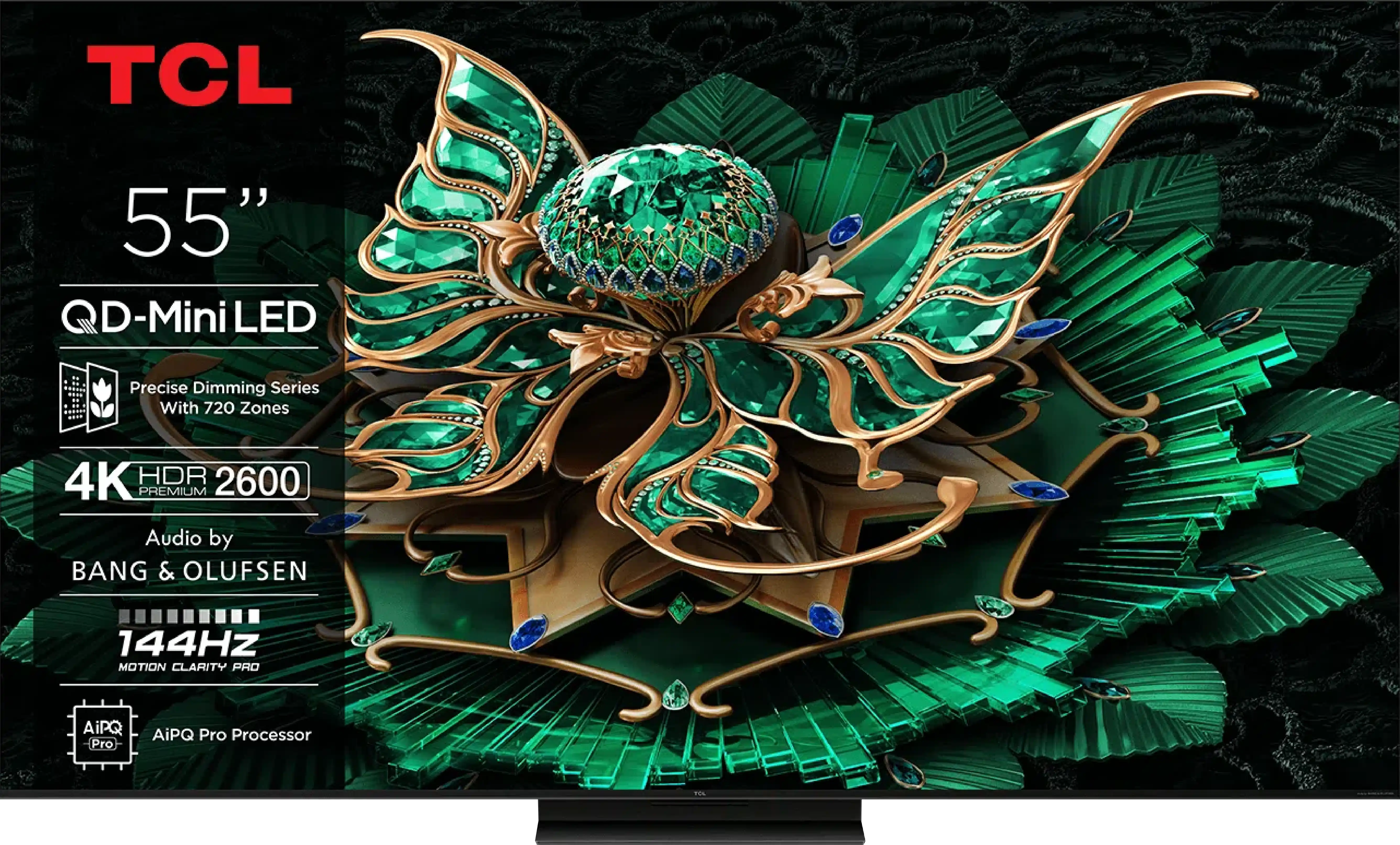
Panel type: LCD VA
Resolution: 3840x2160
System: Google TV
Model year: 2025
Complete the survey to find out the result

Panel type: LCD VA
Resolution: 3840x2160
System: Google TV
Model year: 2025
Complete the survey to find out the result

Overall rating
7.6
7.4
Movies and series in UHD quality
7.0
7.2
Classic TV, YouTube
7.4
6.9
Sports broadcasts (TV and apps)
7.2
6.8
Gaming on console
8.7
8.7
TV as a computer monitor
8.0
8.4
Watching in bright light
6.9
6.4
Utility functions
7.6
7.3
Apps
9.6
9.6
Sound quality
7.0
7.7
Complete the survey to find out what fits your preferences
Advantages
Exemplary upscaling and digital image processing – proprietary Sony XR processor
Very good image quality after calibration
Solid contrast for a Mini-LED screen
Excellent support for HDR content thanks to Dolby Vision and dynamic tone mapping
High motion smoothness at 120Hz
Outstanding input lag (7 ms at 120 Hz)
Very good cooperation with PC – super readability of fonts, G-Sync and FreeSync Premium Pro support.
Google TV at its best, fast and without annoying bugs
2 remotes included
Pleasant, loud sound at 40 W from a 2.2 system.
Very good black - VA panel with a large number of Mini-LED zones
High brightness in HDR - over 1000 nits
Great for gamers - HDMI 2.1, low input lag, VRR, ALLM, etc.
Good motion fluidity - 144Hz panel
Supports multiple HDR formats: HDR10, HDR10+, Dolby Vision
Google TV operating system with access to a huge app library
Pleasant sound from built-in speakers (6.2.2) Bang & Olufsen
Disadvantages
The algorithms need refinement – despite the higher number of dimming zones, contrast and brightness in difficult scenes sometimes perform worse than in the X90L
Screen mirroring practically did not work with Windows and Android
Only two HDMI 2.1 ports – for a TV of this class, that's definitely too few, especially if someone plans to connect a console, soundbar, and additional devices
Google TV can work with minor stutters
No USB recording and PiP function
Our verdict
There are TVs that make it to reviews and at first glance seem like just another "mediocre" model. The TCL C7K looks just like that – without big slogans about revolution, without ambitions to dethrone OLEDs. Yet after spending a few days with this model, it's hard not to come to the conclusion that it's truly a successful piece of equipment. The biggest advantages? Very good picture quality at a reasonable price. MiniLED combined with a QLED filter delivers vibrant colors, high brightness, and contrast that really impresses in this class. Motion in sports or games looks smooth, and the presence of HDMI 2.1 and 144 Hz refresh rate makes gaming on this model pure enjoyment. Additionally, the Google TV system offers a huge range of possibilities: from voice control, to AirPlay support, to access to all the most important applications.
Are there any drawbacks? Yes. MiniLED still has its limitations, and in the most challenging movie scenes, compromises in dimming can be noticeable. Google TV also doesn't always operate perfectly smoothly. But these are rather minor issues that do not overshadow the overall picture – which is truly positive. It’s also worth highlighting the difference between variants. The 50-inch version we tested can be surprising, but the 55–85 inch models perform distinctly better – they have more backlight zones, even better contrast quality, and superior sound. Therefore, if you're considering purchasing the C7K, it's definitely worth going for a larger size.
TV appearance




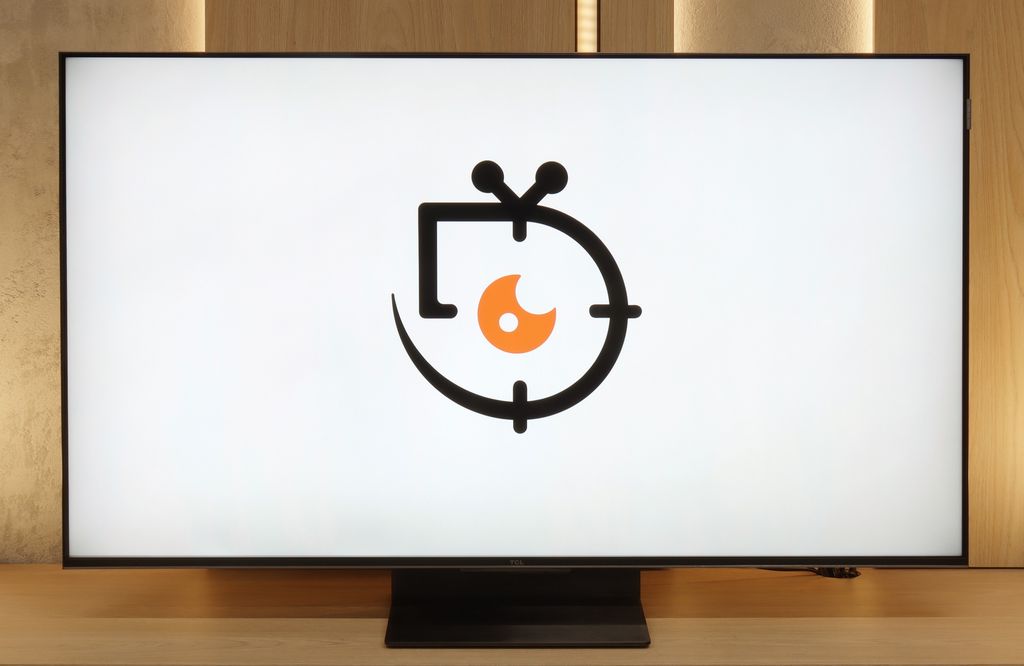
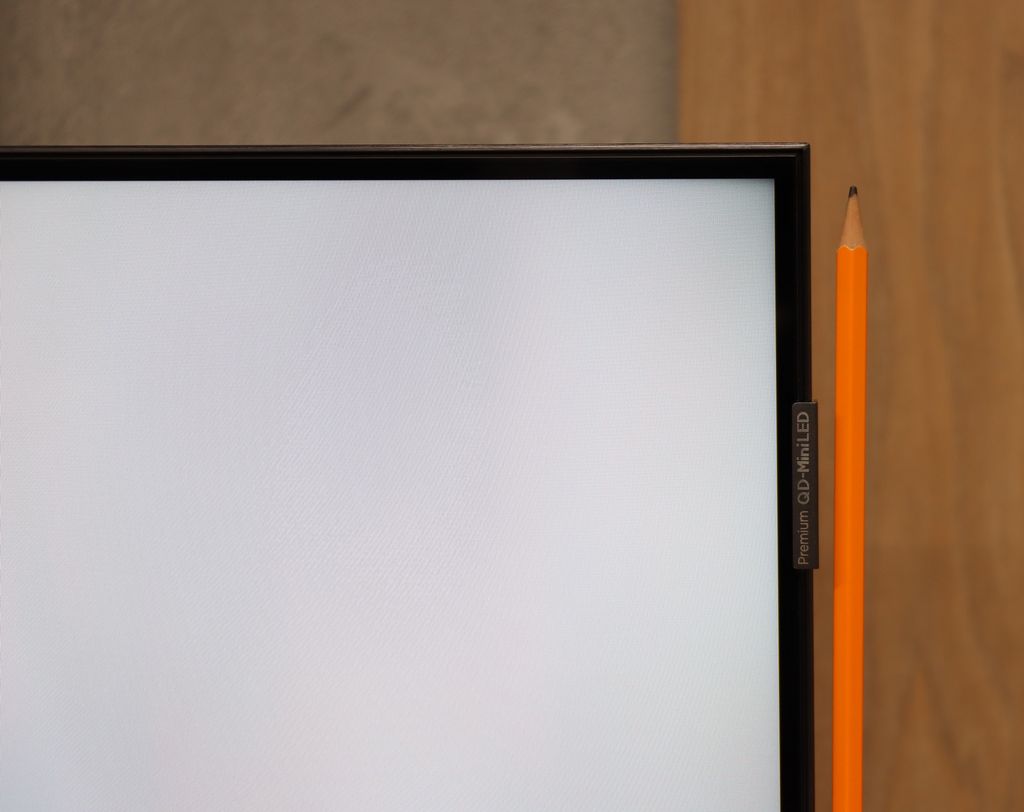
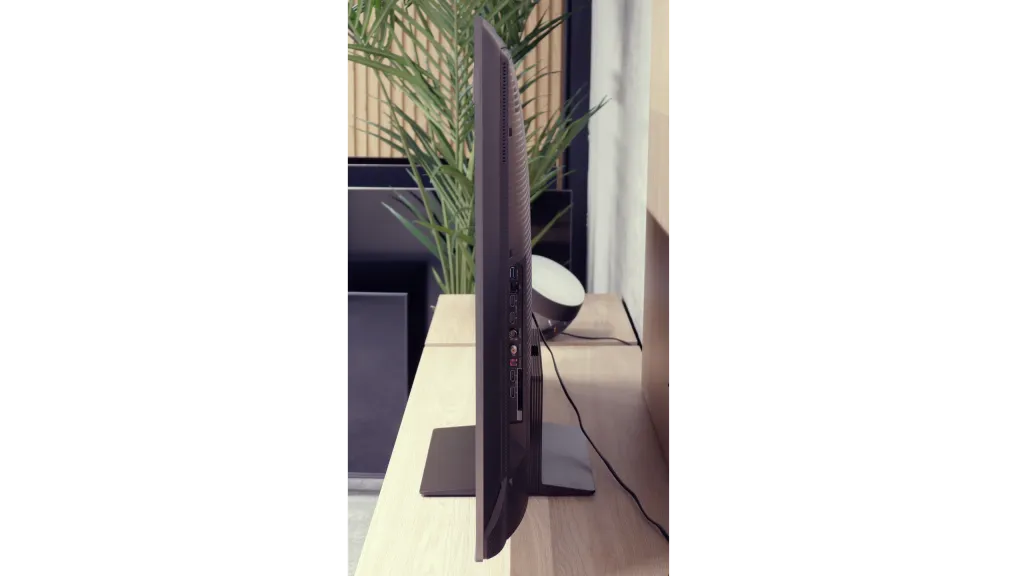
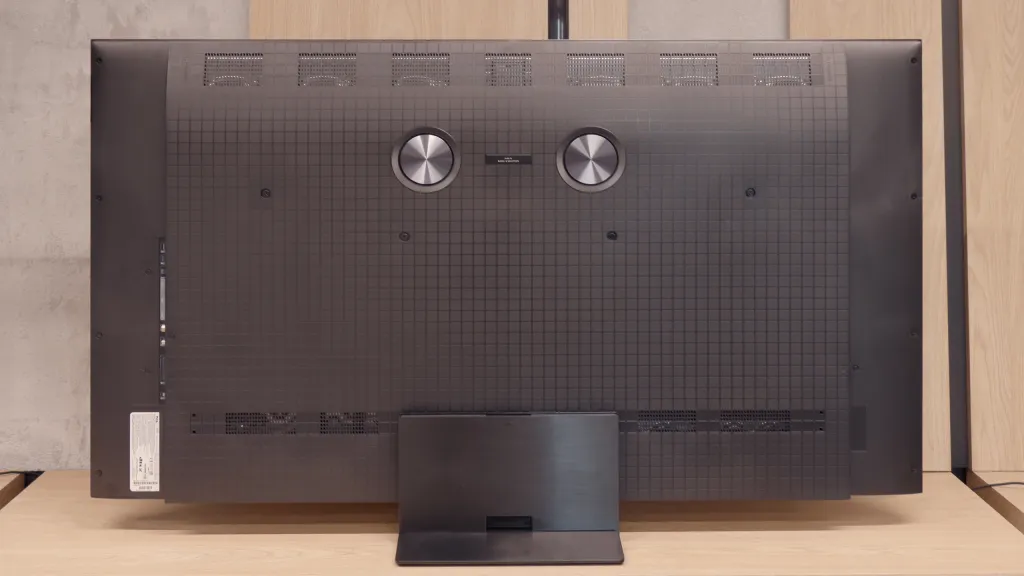
Contrast and black detail
7.5/10
8.1/10
Local dimming function: Yes, number of zones: 190 (10 x 19)
Local dimming function: Yes, number of zones: 1008 (42 x 24)
Contrast:

Result
104,650:1

Result
23,850:1

Result
21,300:1

Result
9,350:1

Result
6,450:1

Result
256,000:1

Result
59,850:1

Result
22,200:1

Result
16,850:1

Result
11,400:1
Halo effect and black detail visibility:

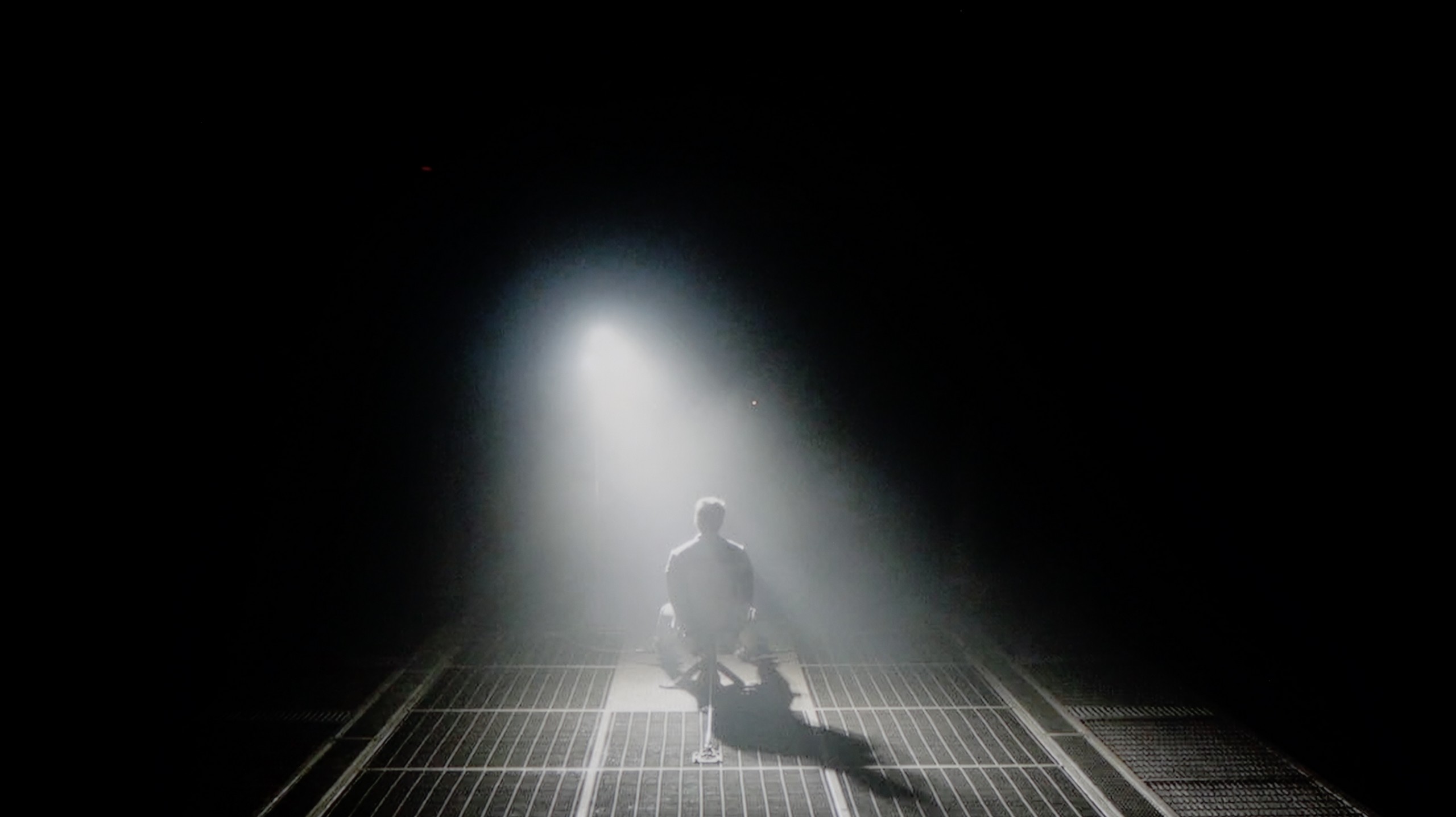
Bravia 5 is the entry-level television in Sony's Mini-LED series for 2025, so naturally, we start with the most important aspect – how it performs with black levels and contrast. After all, the term “Mini-LED” sounds almost like a magic spell today. In theory, it means thousands of tiny LEDs arranged in zones that are supposed to work in harmony, dimming and brightening the image so that the viewer's eye perceives more depth than in a classic LCD. In practice, we counted about 200 backlighting zones in the 65-inch Bravia 5. Is that a lot? Definitely more than in its predecessor, the legendary X90L model, but when looking at Chinese manufacturers who can pack hundreds, sometimes even thousands of zones, it comes off as fairly modest.
One would expect that combining a greater number of zones with refined dimming algorithms—something Sony has trained us to expect over the years—would result in a significant quality jump compared to the X90L. Meanwhile – and this is where a slight disappointment comes in – tests showed that the results are surprisingly similar to last year's model. Don’t take this the wrong way: the contrast for an LCD TV with local dimming is genuinely solid. In most scenes, bright elements are separated from dark ones with almost surgical precision, and the effect can be impressive. But when more demanding shots appear on the screen—those that ruthlessly test the backlighting capabilities—it becomes clear that the hardware has its limitations.
Therefore, one could say that in terms of black levels and contrast, the Bravia 5 does not so much disappoint as it rather fails to meet the hopes that the initial announcements raised. We were counting on at least slightly better performance than its predecessor, and we got “only” good contrast. And that “only” is the key word here—because good contrast in Sony’s version still means a level that most competitors could be proud of.
The results of black and contrast tests on models from 55 to 85 inches are very similar, which is why in the main part of the evaluation we refer to the 65-inch version. It is a natural phenomenon that larger sizes mean a greater number of backlight zones, and in the case of 65 inches, we counted over 1000. The effect is very good – the contrast is at a high level and is definitely better than in the smallest, 50-inch variant. Typical MiniLED limitations are still noticeable, such as the halo effect or a somewhat too aggressive dimming of the image, but here they are less perceptible than in the smaller model.
For comparison, it is worth recalling that the 50-inch TCL C7K, although surprising with its use of as many as 336 dimming zones, had difficulties managing the backlight in more complicated scenes – there were instances of overexposure or loss of detail. In larger sizes, this problem does not disappear completely, but thanks to a greater number of zones, its impact on the image perception is less bothersome.
HDR effect quality
5.4/10
6.2/10
Luminance measurements in HDR:

Result
637 nit

Result
320 nit

Result
550 nit

Result
251 nit

Result
731 nit

Result
1108 nit

Result
405 nit

Result
865 nit

Result
290 nit

Result
848 nit
Scene from the movie “Pan” (about 2800 nits)


Scene from the movie “Billy Lynn” (about 1100 nits)

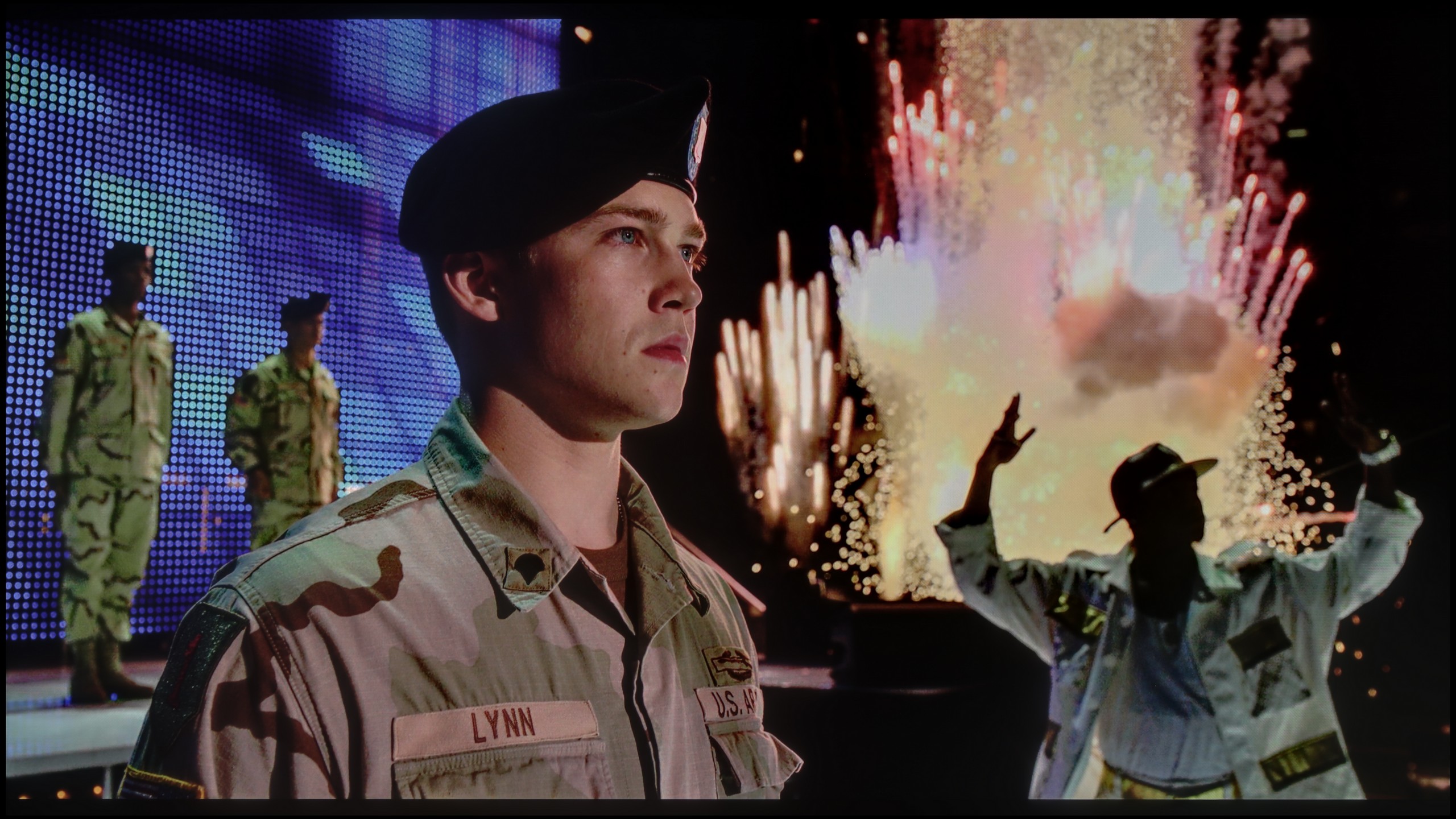
Static HDR10


Dynamic: Dolby Vision
Dynamic: Dolby Vision


HDR luminance chart:
TCL C7K / QM7K 55"-85"
HDR luminance
Sony BRAVIA 5 (XR5)
HDR luminance
Looking at similar results in terms of black levels and contrast, we expected the same stable performance as last year's model when it comes to HDR content. Unfortunately – and this must be said plainly – there has been a regression here that is hard to overlook. The paradox is that the peak brightness of the Bravia 5 can be impressive: in our synthetic tests, the television reached around 1000 nits in HDR. Sounds great, right? The problem is that this power does not always translate effectively to all movie scenes. When small, pinpoint elements appear on the screen, something that was usually refined with surgical precision in the case of Sony clearly falters this time. The algorithms try to maintain deep blacks around small objects, but the side effect is that details can be dimmed to the point of becoming barely visible. A case in point is the movie Sicario 2 – there, in some scenes, small light sources practically vanished as if someone had covered them with dark film.
Of course, not everything looks so dramatic. In simpler, brighter scenes, where the image is filled with a greater amount of light, the Bravia 5 shows that it can shine: literally and figuratively. At that point, the television achieves values in the range of 600–800 nits, which we observed in both synthetic tests and during movie screenings. The impression is truly positive; the brightness adds dynamism, and the colors appear vivid and fresh. However, there remains a certain dissonance. We feel a slight confusion because it is evident that something has gone the wrong way. Technological advancement – more zones, greater backlight power – has not been supported by the refined image management we usually associate with Sony. Fortunately, there are elements that have not been worsened and are instead at a very high level. We are talking about color reproduction. Thanks to the use of the PFS filter, the color gamut coverage is excellent – about 97% of DCI-P3 and 75% of BT.2020. These values allow for a truly wide color reproduction, giving films a natural and cinematic character.
In terms of brightness, the models from 55 to 85 inches in the C7K series are truly impressive. In the best testing conditions, the 65-inch screen achieved over 1200 nits, which practically means that the brightest scenes can dazzle with almost cinematic brilliance. These are not just dry numbers from measurements – during screenings, white skies, explosions, or light reflections on water looked incredibly striking, often giving the impression that the television exceeds its price class. This is particularly effective in scenes with a large area of illumination, where the screen is filled with intense brightness – such as in sun-drenched shots or during dynamic action sequences. Viewers looking for strong HDR will definitely be satisfied.
However, scenes requiring precise control of backlighting – with small points of light on a dark background – are more challenging. Here the C7K, despite having over a thousand zones, can still dim brightness to maintain deep blacks. The effect is that in films like Sicario 2 or Life of Pi, some details, such as a distant lantern or single reflections, can be less defined or blend in with the surroundings. This is a compromise inherent to MiniLED technology – it provides excellent image depth and blacks at a level that ordinary LCDs do not offer, but this comes at the cost of limited visibility of the smallest lights.
Factory color reproduction
5.5/10
6/10


Factory Mode
After calibration
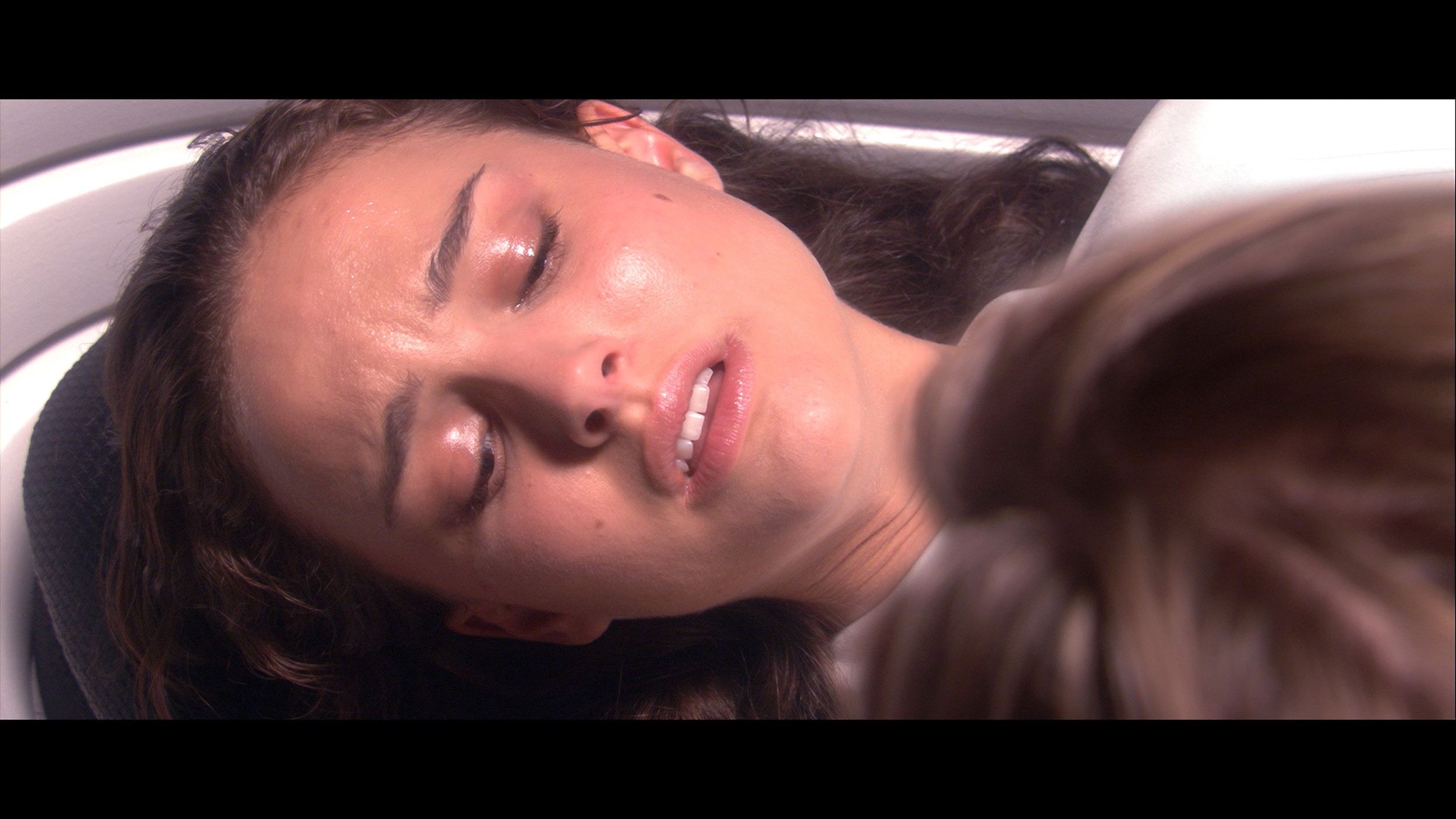
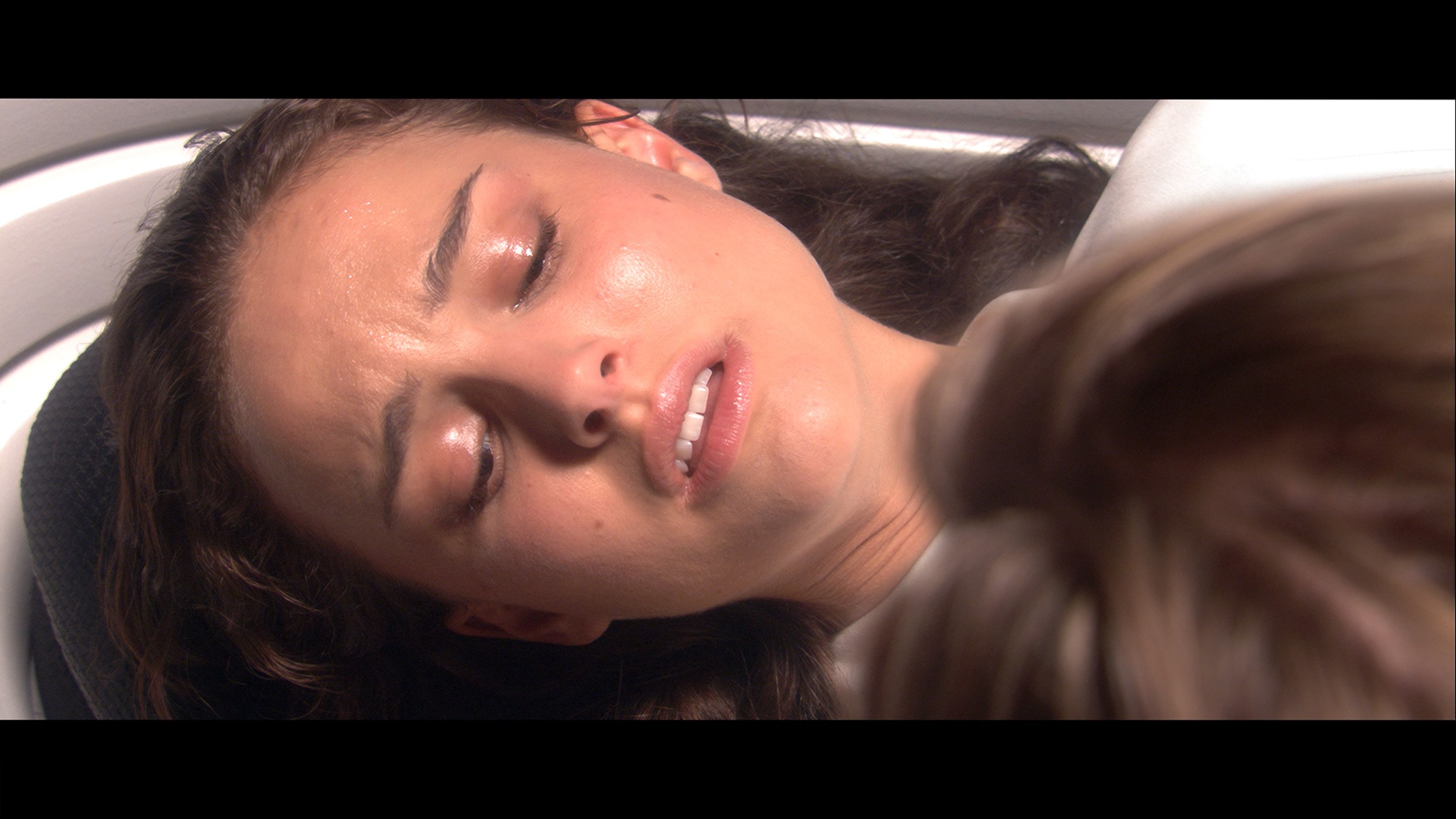
Factory Mode
After calibration
Sony Bravia 5 was of course tested in the best possible mode, which is the Cinema mode. Right out of the box, it offers the most natural colors, definitely better than anything provided by the "eco" or "dynamic" modes, which are more suitable for a store display than a living room. However, the Cinema mode itself does not guarantee that we can always expect cinematic image quality. In SDR content, we had practically no major complaints – the slightly warm white balance made the scenes take on a somewhat golden tone, but it was nothing that was glaringly obvious. However, the problem arose with HDR materials. Here, the color reproduction simply looked poor. The white balance was severely off – with an excess of blue and a noticeable lack of red. At times, it even resembled the store "super vivid image" mode, where everything is overexposed and artificially boosted.
This state of affairs made managing brightness seem too aggressive as well. The EOTF graph clearly showed that the television had issues with overexposing many scenes right out of the box. And while we know what Sony televisions are usually capable of, it was hard to remain indifferent here – which is why we quickly decided to go for calibration.
The novelty in TCL televisions for 2025 is the long-awaited Filmmaker mode, which until now could be found in most competitive brands. This is great news because this mode is considered the most faithful to the original vision of the creators and is often recommended by enthusiasts of good picture quality. Unfortunately – as is often the case – the mere presence of this mode does not guarantee perfection. The Filmmaker mode in the TCL C7K is not free from flaws. One could point out the incorrect white balance, particularly the slight dominance of blue, which led to cool, somewhat grayish skin tones. But that was not the biggest problem. The main complaint was excessive brightness exposure, which is clearly visible in the gamma and EOTF charts. The image was simply too bright, at times almost blown out, which affected not only the depth of scenes but also the overall viewing experience. Some details were simply lost, and the whole image looked as if someone had slightly overdone the brightness slider. As always – we decided to see what could be squeezed out of this after calibration. And that’s when things started to get really interesting…
Color reproduction after calibration
8.9/10
7.5/10

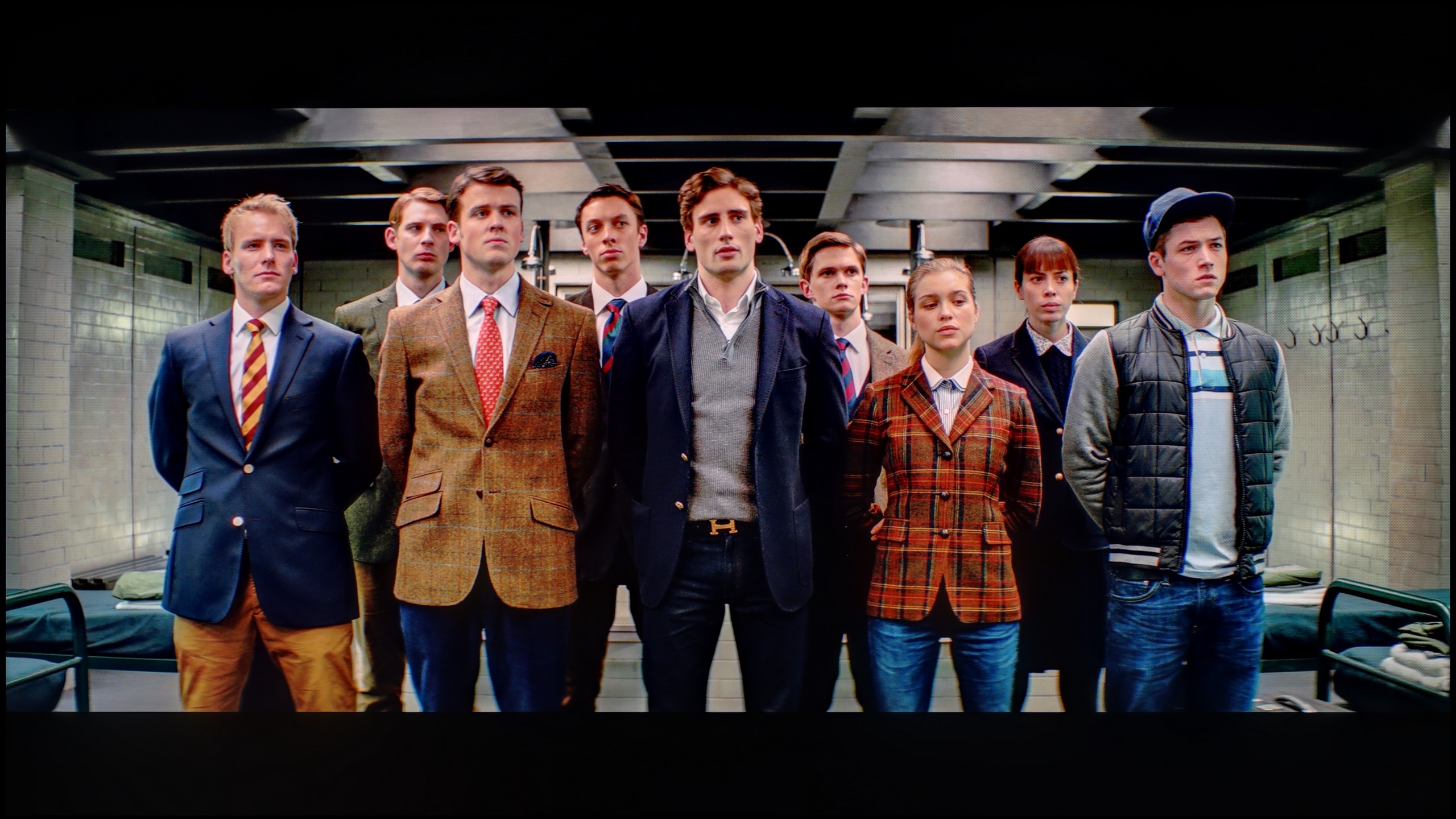

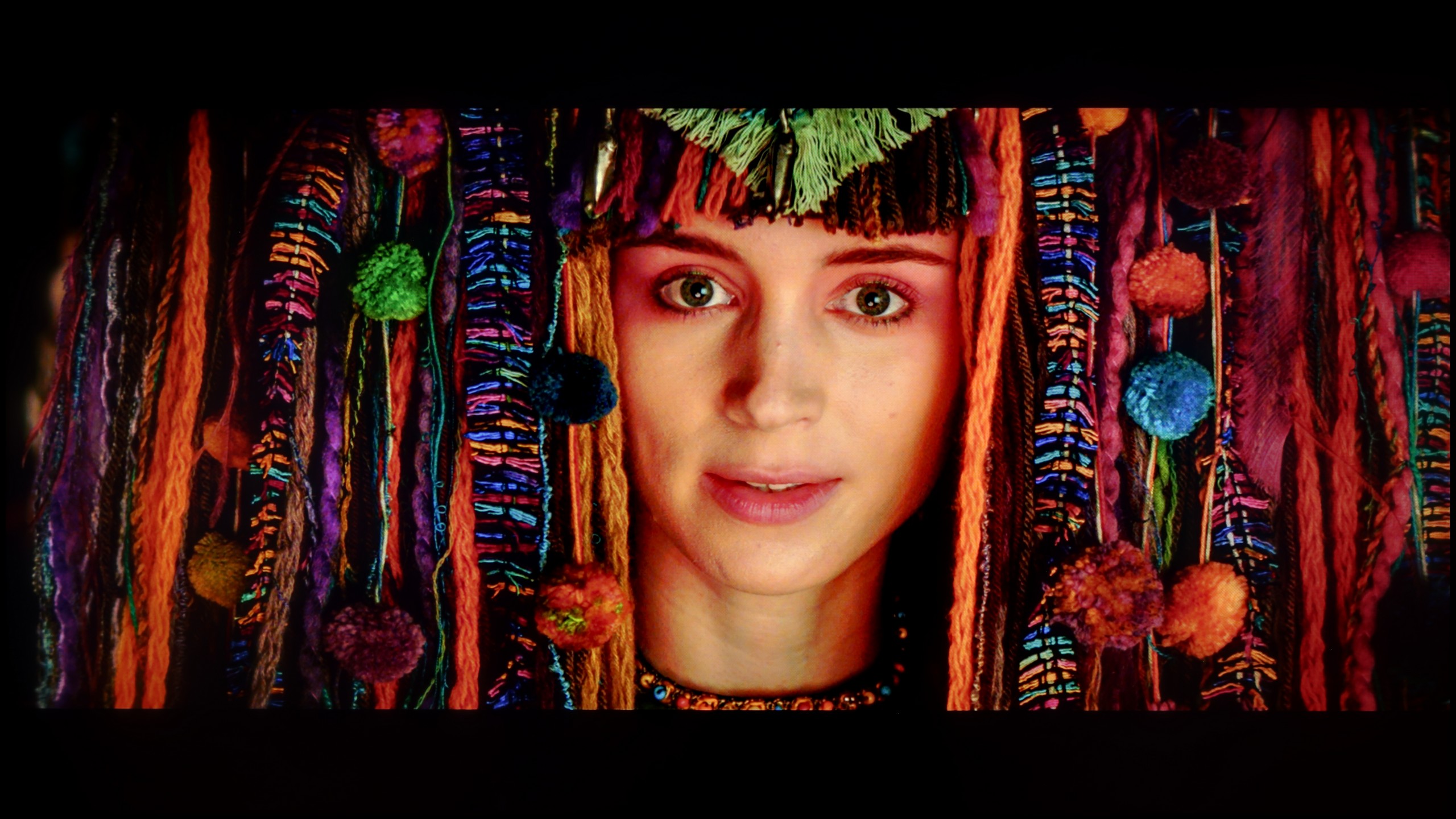
After calibration, the situation changed drastically. We managed to tune the white balance so that entire scenes began to look more natural, and the image gained coherence and elegance. In HDR, we finally got rid of that unwanted blooming effect that had previously ruined some shots. Suddenly, it turned out that the Bravia 5 can extract much more from films than the first contact "straight out of the box" suggested. Yes, if we take a look at the graphs and compare them with the reference patterns, we can see that the start of the EOTF curve slightly deviates from the reference line. However, this is not so much a calibration error as a natural limitation of Mini-LED technology, which cannot be bypassed. Sony, instead of clinging to perfect black, prefers to prioritize the visibility of details – and in practice, it’s hard to disagree with that. We prefer to see the texture of the material on the screen rather than a pitch-black blob that obliterates all nuances.
The calibration itself made a significant difference. After about an hour spent on adjustments, we felt that the picture resembled that from the best cinema halls – of course on a home scale, but with the same sense of quality and refinement. And in such moments, we remember why we love Sony televisions: because once we fine-tune them, they can reward us with an image that captivates for long hours.
After calibration, the TCL C7K showed itself in a really good light, especially when it comes to SDR content. We managed to tune the white balance, color gamut, and brightness characteristics so precisely that color errors on the ColorChecker palette dropped below a value of 2. For the uninitiated – this is almost a perfect result, which means that the image is very close to what the creators intended. Unfortunately, it looked worse with 4K HDR content. Although we were able to slightly calm the white balance and correct its previous errors, it is still evident that the television has some "MiniLED traits," especially in brightness management. When we checked how the C7K handles the EOTF curve on actual film scenes, and not just on synthetic test patterns, it turned out that the screen still tends to slightly brighten the entire image. This affects the overall experience – black loses some depth, and the image becomes less contrastive than it should be. Despite these minor shortcomings in HDR content, the overall reception of materials – especially in SDR – is really very good. After calibration, the C7K can display an image that can successfully compete with much more expensive models. Good color tuning, natural skin tones, and pleasant brightness make movie sessions and everyday content viewing more than satisfactory.
Smoothness of tonal transitions
8.8/10
8.6/10





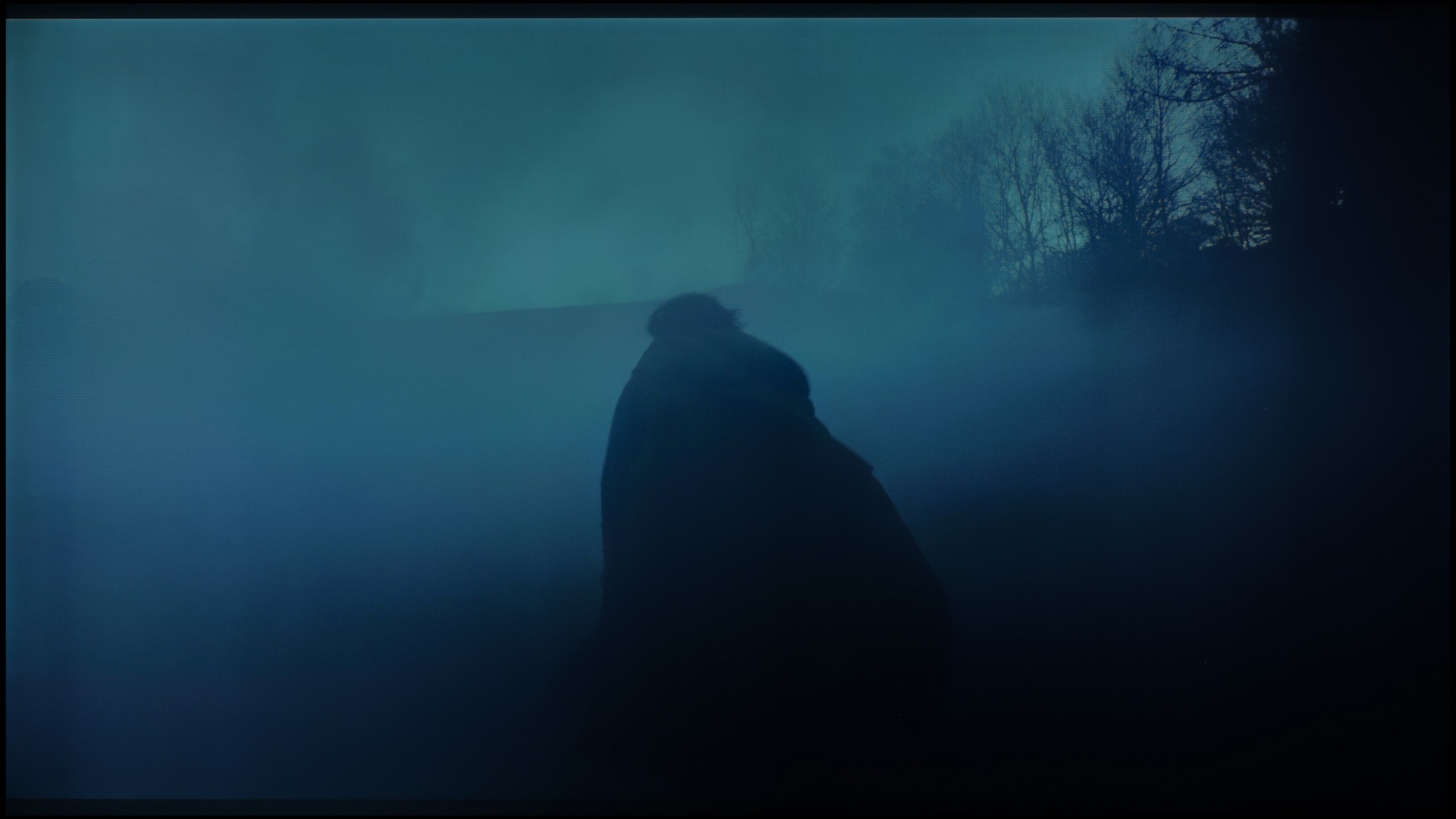

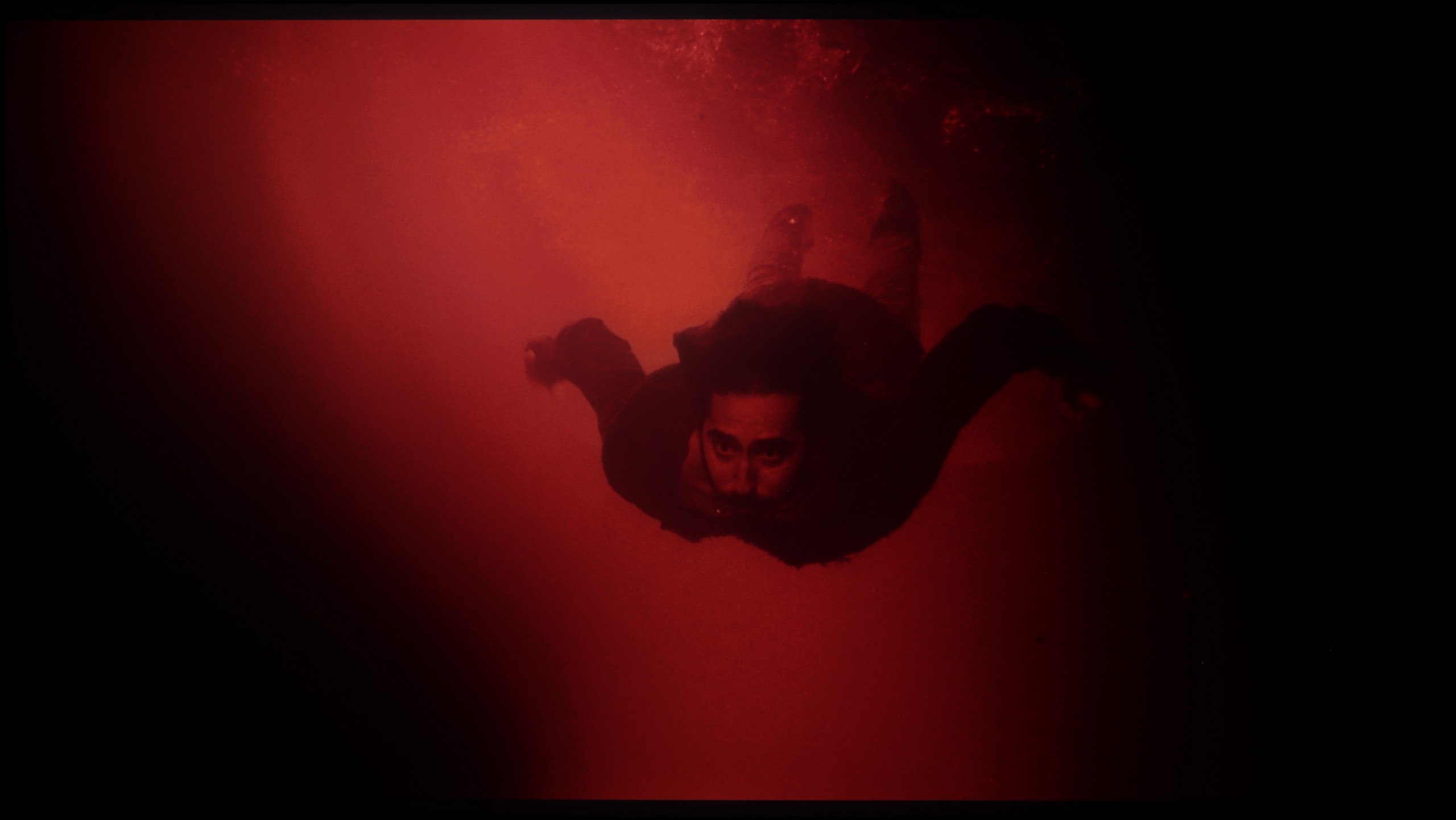




Gradient transitions are nothing more than the way a television handles the blending of colors and shades – from light to dark, from saturated to pastel. If the device has issues with this, characteristic "stepping" is visible instead of smooth transitions, and the image loses its naturalness. It is during these moments, when instead of getting immersed in a movie, we start glancing at the screen thinking: "hey, something is off." Fortunately, in the Sony Bravia 5, such situations are virtually non-existent. This is a huge advantage, as nothing detracts our attention from the plot or the excitement of sports. The television performs best in bright scenes, where color transitions are smooth, and color blends are almost invisible. The effect is so good that sometimes one might get the impression that the image was painted in one brushstroke. Of course, there were some minor hiccups. In darker scenes, certain imperfections can be noticed – slight stepping or minimal gradation issues. For that, the Bravia 5 received a few negative points from us. Nevertheless, in the vast majority of situations, the television performs excellently and emerges from this test with flying colors.
TCL C7K handles color gradation very well – in most tested scenes, the tonal transitions were smooth, and the colors blended together without visible outlines or an artificial “blots” effect. In everyday use, it’s hard to find anything to complain about – the image looks natural, without irritating transitions or digital artifacts. Certain limitations only appear in very dark tones – especially in a heavily muted gray palette, where the television may struggle to reproduce the perfect gradation. But that’s absolutely understandable, as even many significantly more expensive models in this range simply give up. Fortunately, these situations are rare and do not significantly affect the overall perception.
Image scaling and smoothness of tonal transitions
8.5/10
5.5/10
Smooth transition function

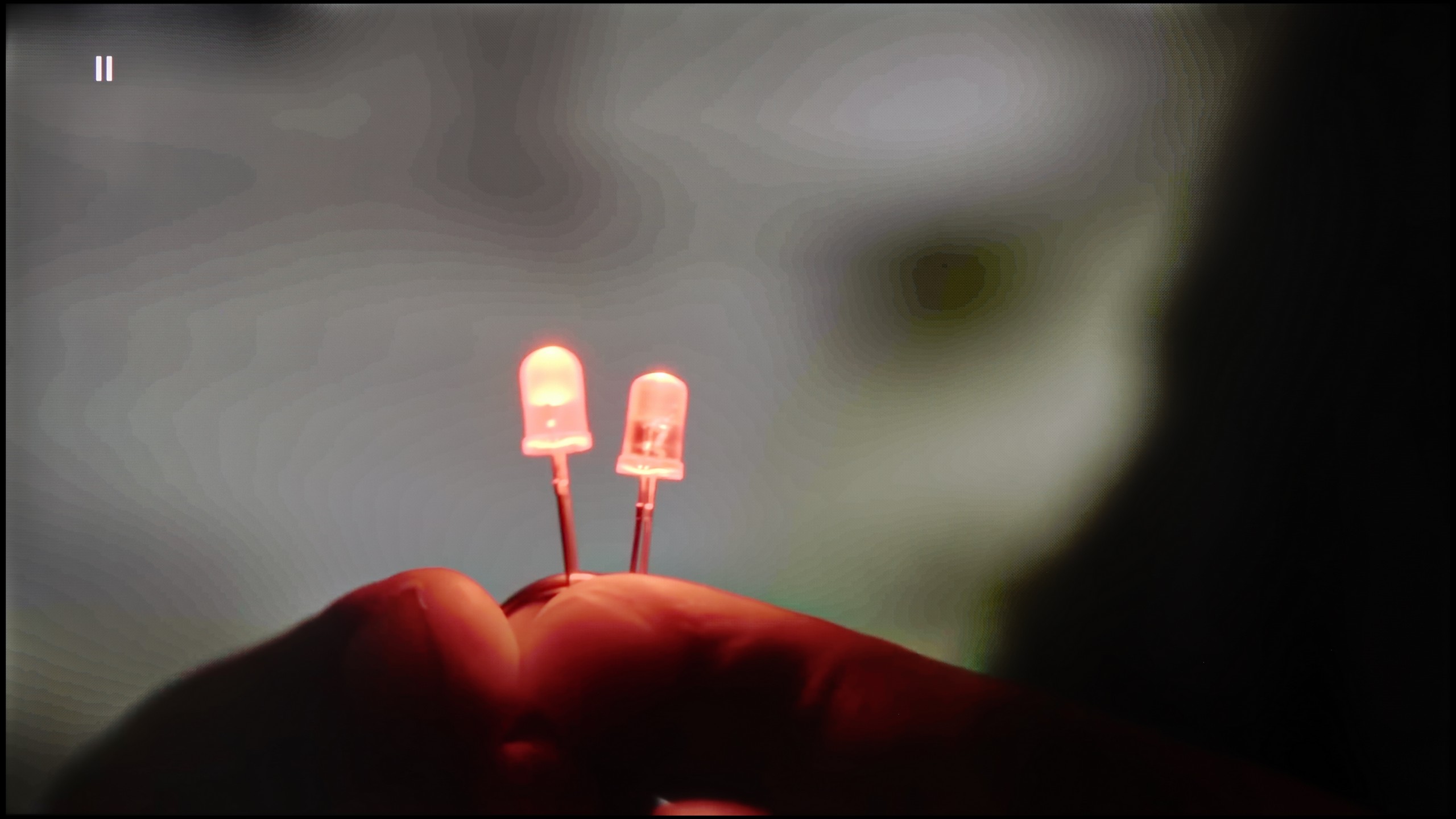
Image without overscan on the SD signal


Bravia 5 carries within it the genes of Sony, which remain intact – and thank goodness for that, because we are talking about absolutely remarkable digital image processing. There is a reason that for years it has been believed that it is this brand of television that sets the standard for how a screen should handle lower-quality materials. If someone is still watching classic television, old movies, or YouTube in lower resolution, here they get equipment that can turn such content into a surprisingly pleasant experience. On board, we find several tools worth activating. The first of these is "digital noise reduction." Set to a medium level, it works almost flawlessly – smoothing tonal transitions that usually pose the biggest challenge with low-quality materials, while not introducing any artificial artifacts. Importantly, it also does not remove the filmic character, or the natural grain that is an intentional element in many productions. Another advantage of Bravia 5 is the upscaling capabilities of the XR processor. The image presented after scaling is soft yet sharp and clear. The contours of characters are well-defined, and backgrounds retain their structure without excessive artificial sharpening. It’s hard to find a better television for watching lower-quality content – Bravia 5 only confirms why Sony is regarded as the benchmark in this field.
TCL C7K features a function that, according to the manufacturer, is supposed to smooth out unwanted color transitions – something like a rescue for less successful tonal changes. It's called "Gradual Smoothing" and... well, it sounds ambitious, but in practice, it works very poorly. Regardless of whether we set it to low or high, the difference is minimal. Worse still – the function can cut out elements from the image that should remain. Fortunately, film grain remains untouched, so at least it doesn't smooth everything indiscriminately, but still – it's better to just turn this option off.
When it comes to scaling lower-resolution content, it's already better. SD and HD materials look quite decent, although sometimes we felt that the image loses sharpness and becomes too soft – as if something took away its clarity. Fortunately, with very low sources (e.g., 576p), there was no overscan effect, meaning the image was not artificially cropped – everything fit on the screen as it should.
Blur and motion smoothness
7.7/10
8.1/10

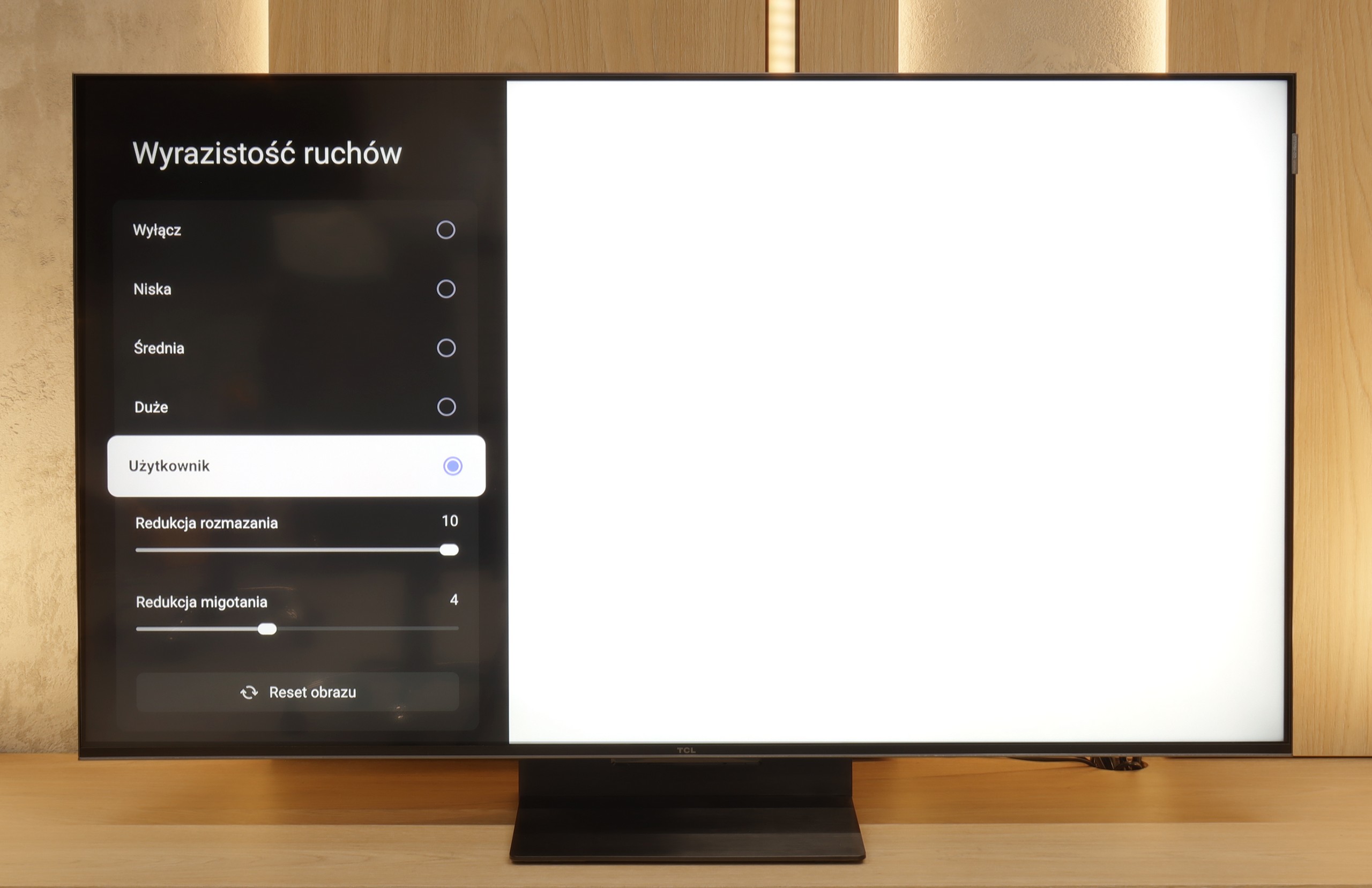
Blur (native resolution, maximum refresh rate):





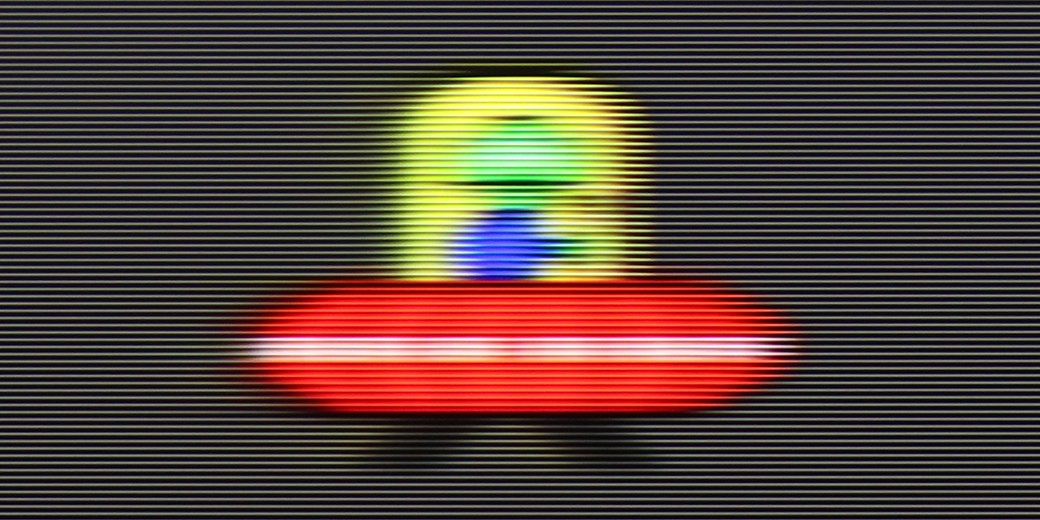
Blur (BFI function enabled):






Smużenie (MotionFlow ON):



Smużenie (4K@144Hz):



Bravia 5 has a 120 Hz panel, which in itself sounds like an invitation to watch sports, fast matches, or spectacular action movies. However, the real magic begins only when MotionFlow comes into play – Sony's proprietary smoothing technology. Thanks to it, we can adjust the character of the image to our own preferences. The “smoothness” slider allows us to transition from a cinematic vibe with a slight “jitter” of the film frame to an almost theatrical fluidity, where every ball in the game glides across the screen like on a string. The higher the value, the smoother and more fluid it is; the lower – the more cinematic and natural. In the options, we also find an additional setting that Sony has called “clearness.” This is nothing more than the BFI function (which stands for black frame insertion), which aims to improve motion clarity. It sounds great in theory, but in practice, you need to use it with great caution. Why? Because all higher settings cause brightness drops of up to half, and in some cases, there can also be contour doubling. Therefore, if we want to use it, we recommend the lowest possible level – “1” out of the available ten. This way, we gain a little better motion clarity without risking a loss of half the image brightness.
The TCL C7K handles motion fluency really well. The panel used in it offers a refresh rate of 144 Hz, which in itself suggests that this TV is something more than just an ordinary "60 Hz" panel. Moreover, if we connect the C7K to a computer and set the resolution to Full HD. But we'll write more about that in the paragraph about gamers and PC collaboration. Back to everyday use – both sports and movies look very good here. Thanks to the fast panel and well-functioning motion smoother, the C7K is great for watching matches, but also for movie screenings. In the menu, we find two sliders – blur reduction and flicker reduction – which allow you to tailor the smoothness effect to your own preferences. At lower settings, we get a more cinematic effect, with a slight stutter in motion. At higher settings – the image becomes more theatrical, smooth to the point of exaggeration. Everyone can set it up according to their liking.
Console compatibility and gaming features
9.8/10
9.8/10
- ALLM
- VRR
- VRR range48 - 120Hz48 - 240Hz
- Dolby Vision Game Mode
- Correct implementation of HGIG
- 1080p@120Hz
- 1440p@120Hz
- 4K@120Hz
- Game bar

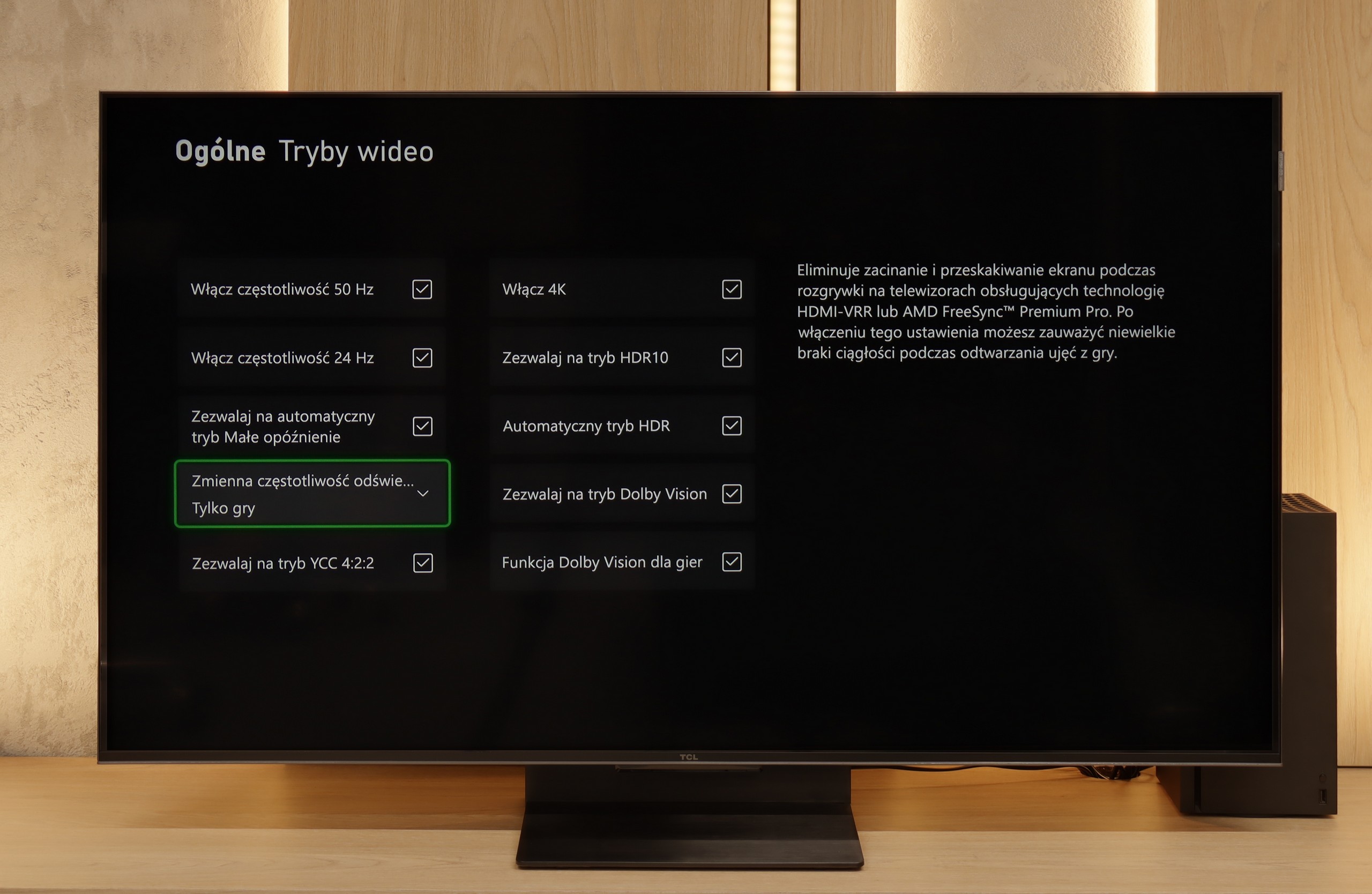

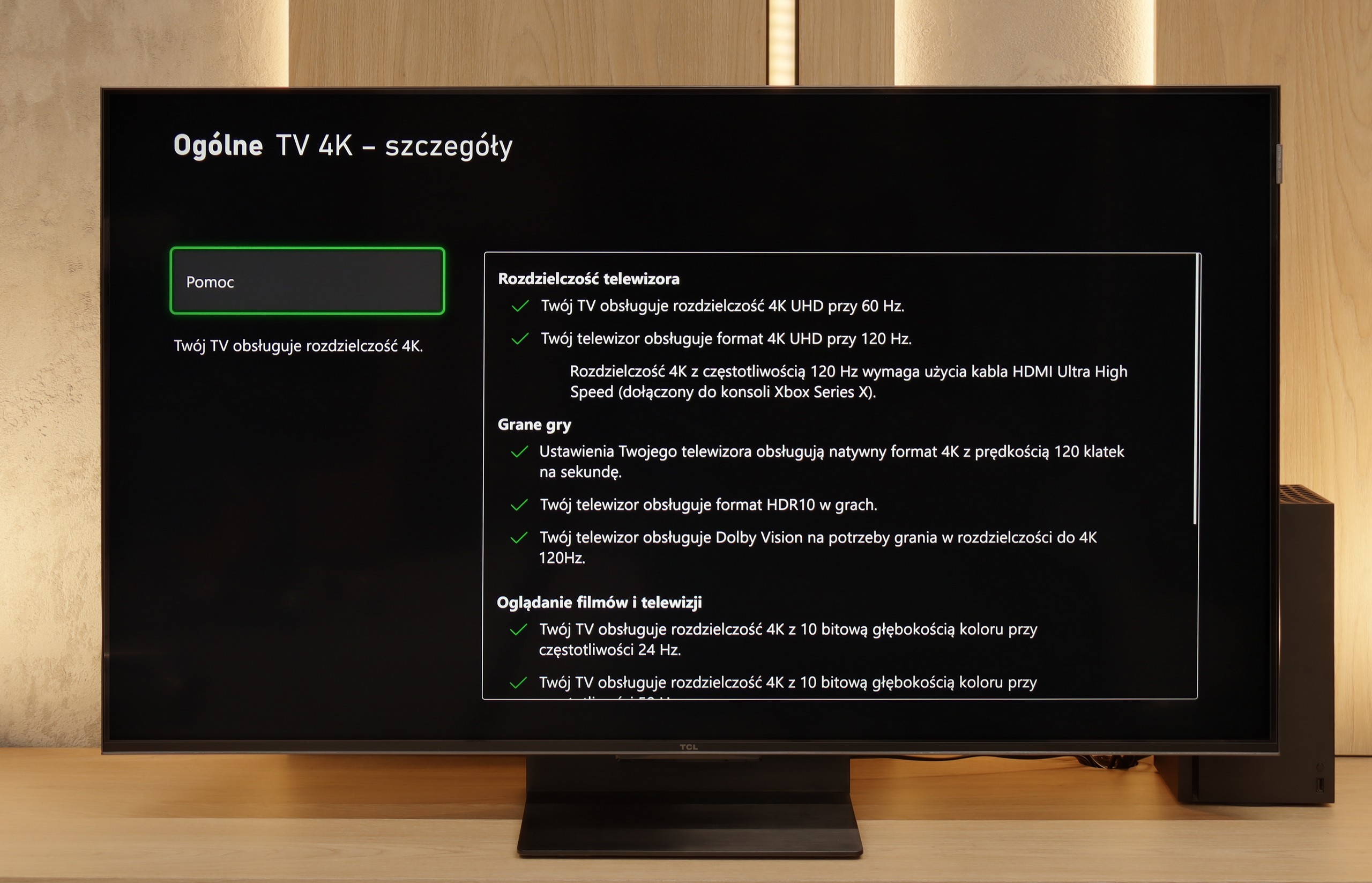

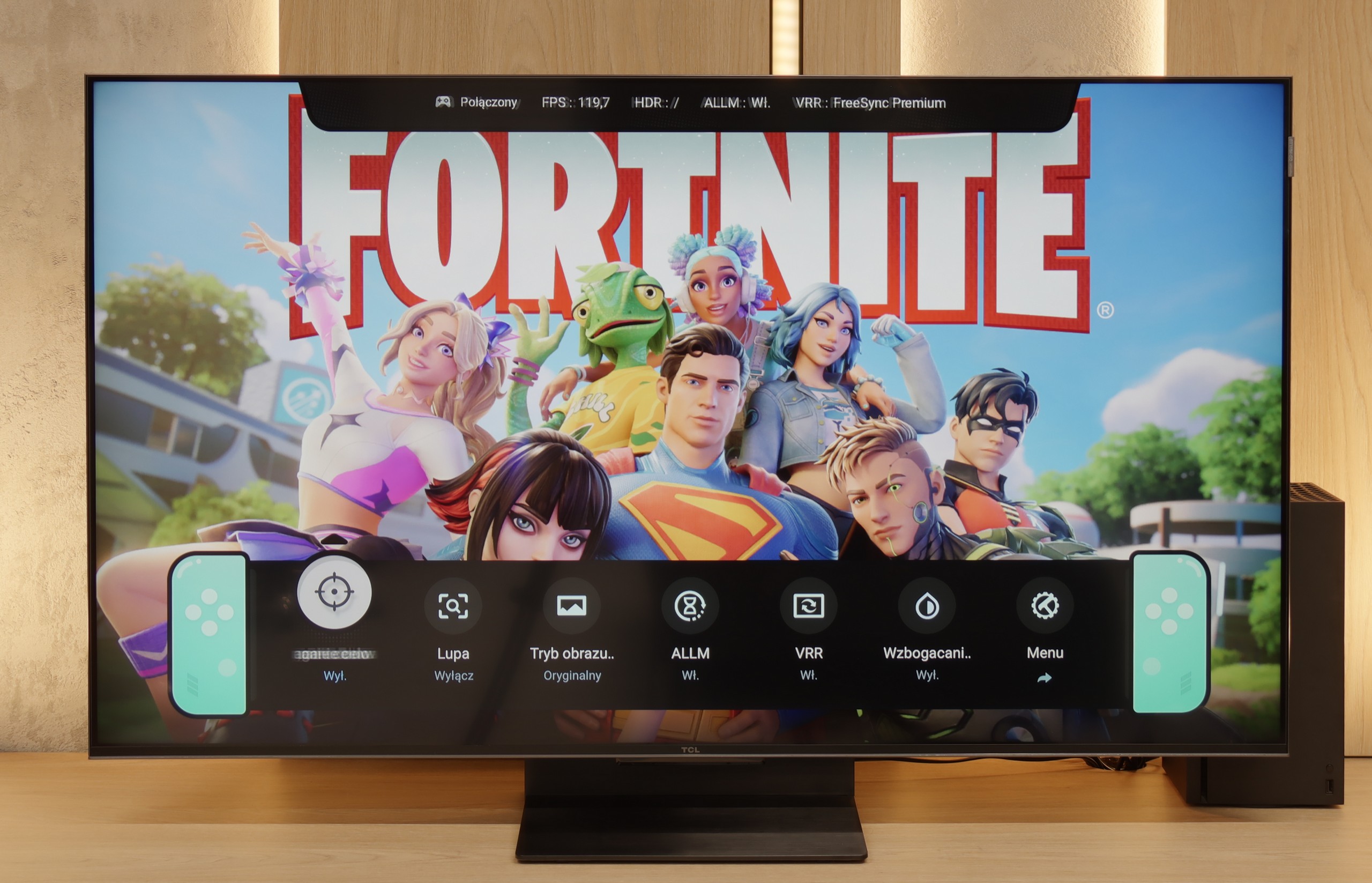

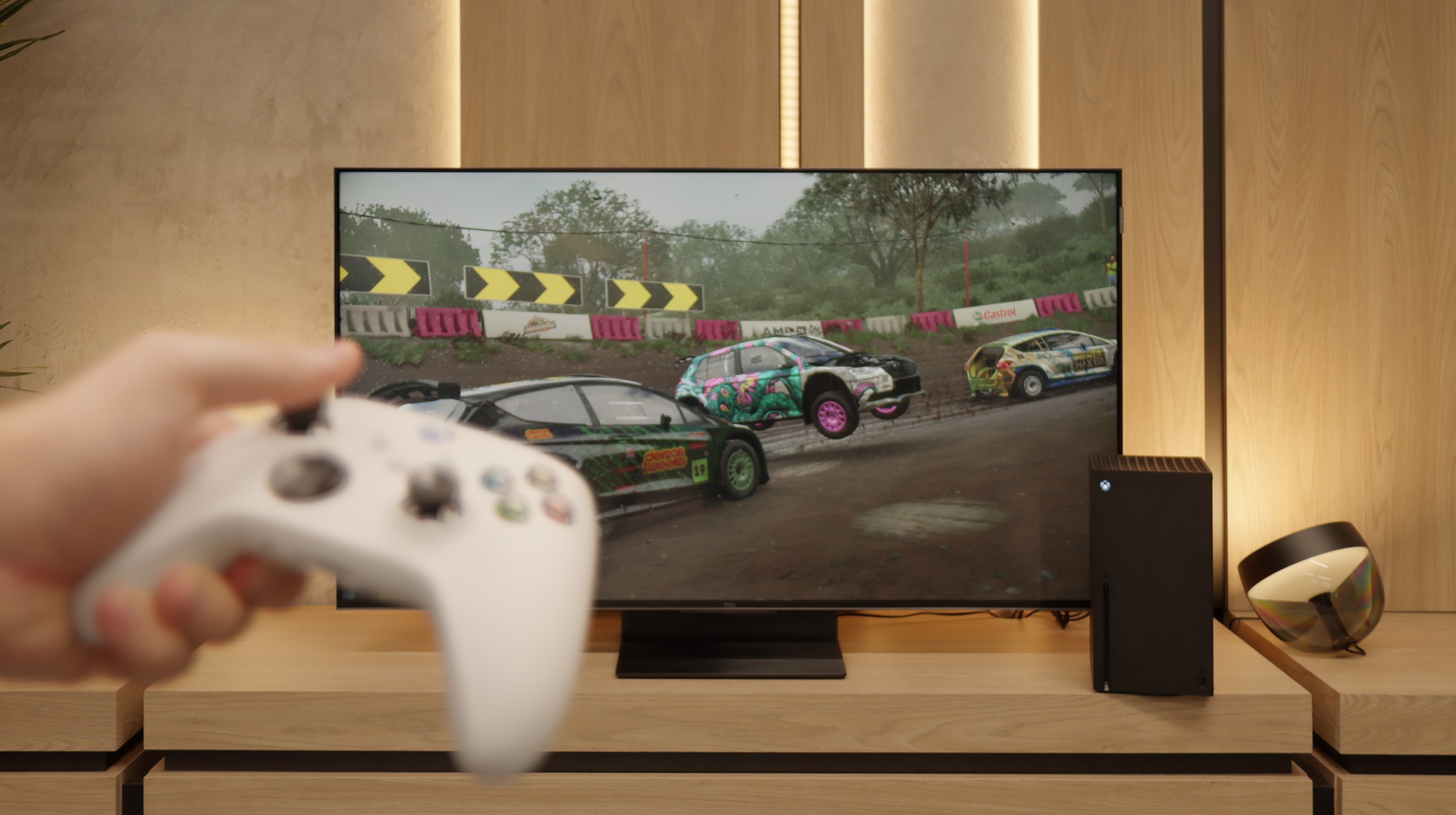
In the Bravia 5, there is significant progress compared to the X90L model from two years ago. The television offers literally everything that its predecessor had, but this time the issues that could irritate gamers have been fixed. The problems with setting up variable refresh rate (VRR) have disappeared, and there are no longer any issues with configuring HDR content in HGiG mode. In short: we get a device that simply works as it should without any fuss. The Bravia 5 thus has everything one could expect from a modern gaming television – and it could be advertised with the slogan "ready for PS5" without exaggeration. This is a statement we couldn't make about the X90L model. Hats off, Sony!
It's just a shame that in such a relatively high-priced model, a complete set of four HDMI 2.1 ports is missing. In everyday use, this won't be a problem for most people, but if someone has a console, soundbar, and additional equipment connected via HDMI, at some point there will be a need to either choose or juggle cables.
TCL C7K is a television that on paper looks like the dream equipment for gamers – and most importantly, it holds up well in practice. First, the good news: we have two full-bandwidth HDMI 2.1 ports, so we can easily connect both a console and a computer, taking full advantage of their capabilities. The panel itself supports a refresh rate of 144 Hz, which provides a significant advantage in dynamic games. Additionally, it comes with a full suite of gaming features: VRR (variable refresh rate), ALLM (automatic low latency mode), and support for Dolby Vision in games. There's also an HGiG mode that allows for HDR effects consistent with the creators' intentions. GameBar, which is an informative bar for the gamer. It operates quickly, looks clear (like the Nintendo console👌), and shows what’s most important: the current frame count, VRR status, and even HDR parameters.
Input lag
9.9/10
9.6/10
SDR
HDR
Dolby Vision
When it comes to input lag, the Bravia 5 deserves a round of applause. Results around 7 ms at 120 Hz content are simply outstanding – it's hard to imagine a player complaining about such responsiveness. Even at 60 Hz, where the delay increases to around 15 ms, we're still talking about values that absolutely do not spoil the fun and can't be felt in practice. Moreover, Sony has finally tamed the Dolby Vision mode. In the X90L, it was practically unplayable – delays rose to levels as high as 150 ms. Meanwhile, in the Bravia 5, input lag remains at the same low level as with other content. This is a huge improvement and further proof that this TV can truly be called "gamer-friendly."
When it comes to delays, the C7K gives no reason to complain. In games at 120 Hz, the input lag is around 10 ms, which means the television responds really quickly. Interestingly, even in Dolby Vision mode, the result is very similar, which is not always the standard. Good job, TCL. At 60 Hz, the lag naturally increases a bit, but that's completely normal and applies to virtually every television with a refresh rate of 120 Hz or higher. The most important thing is that everything still operates smoothly and there’s no feeling that something is unresponsive to our actions.
Compatibility with PC
8/10
8.4/10

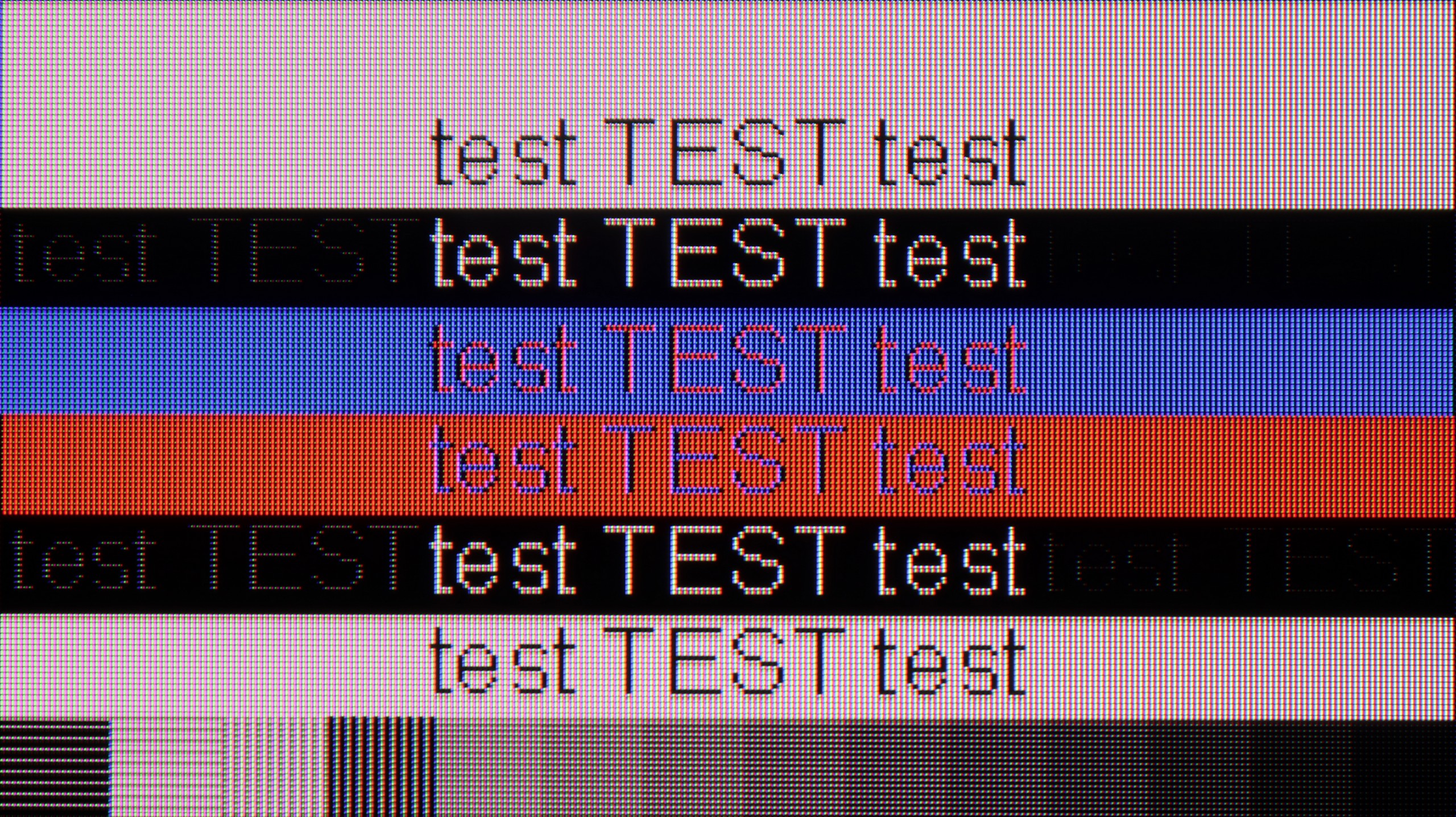
In this category, the Bravia 5 deserves an exemplary rating. The ideal clarity of fonts thanks to 4:4:4 chroma support makes working with a computer on this television a pure pleasure. Whether we're opening Excel, browsing documents, or simply surfing the web – the text is sharp, clear, and free from that characteristic “haze” that can effectively diminish the joy of use in many televisions. The letters look just as they should: clear, sharp, and readable even up close.
We also have good news for PC gamers. The Bravia 5 has no problems handling 120 Hz; it works with both Nvidia and AMD cards, supporting G-Sync and FreeSync Premium Pro technologies. The result is that the image is not only smooth but also free from tearing or micro-stutters that can spoil the experience even in the best-optimized games. So you can confidently connect a powerful computer and enjoy gaming on a large screen – without compromises, without frustration, and with full comfort. The only thing we can nitpick about is the lack of additional modes for gamers with higher refresh rates.
If we intend to connect the C7K to a computer – especially for gaming – there’s really a lot to play for. We have 4K at 144 Hz, which sounds great on its own, but if we lower the resolution, the TV can display even 280 Hz. In e-sports, where every fraction of a second counts, this really makes a difference. Additionally, it supports G-Sync and FreeSync, so no matter what graphics card we have – the image will be smooth, without any stuttering or tearing.
However, if we plan to place the C7K on a desk and use it like a monitor, it’s a bit less "rosy." Yes, it supports chroma 4:4:4, so the fonts should be sharp, but with very dark letters, there’s a slight blurriness and dimming of the edges. It's not something that immediately stands out while gaming or watching, but when working with text – it can be distracting. In everyday use – rather without concerns, but if we plan to place 50 inches a meter from our face, it’s worth keeping this in mind.
Viewing angles
3.2/10
3/10
Bravia 5 uses a classic VA panel, which means one thing – viewing angles are not its strongest point. For owners of smaller sizes, this will not be a problem, as sitting directly in front, the picture looks great. However, with larger sizes, especially 85 inches, the situation becomes less comfortable. It’s enough to sit slightly off-center on the sofa to notice small imperfections: the image starts to lose saturation, contrast weakens, and blacks take on unwanted grays. It’s a pity that Sony did not decide to use additional coatings that can bring the capabilities of VA panels closer to those of IPS panels. Such solutions exist, and some competitors use them. Here they are missing, so one must consider that Bravia 5 best showcases its strengths when viewed directly.
There are no surprises here – the C7K has classic viewing angles for a VA panel. That is: sitting directly in front – it’s great. The colors look good, the contrast is strong, everything is in place. But just slightly shifting to the side begins to worsen the experience – the image loses saturation, blacks turn gray, and the overall impression suffers a bit. So if we plan to watch together with several people or have a couch that occupies half the living room – it’s worth seating everyone more centrally. You can watch from the side, but don’t expect miracles – it’s just a characteristic of VA panels.
TV efficiency during daytime
6.9/10
6.4/10

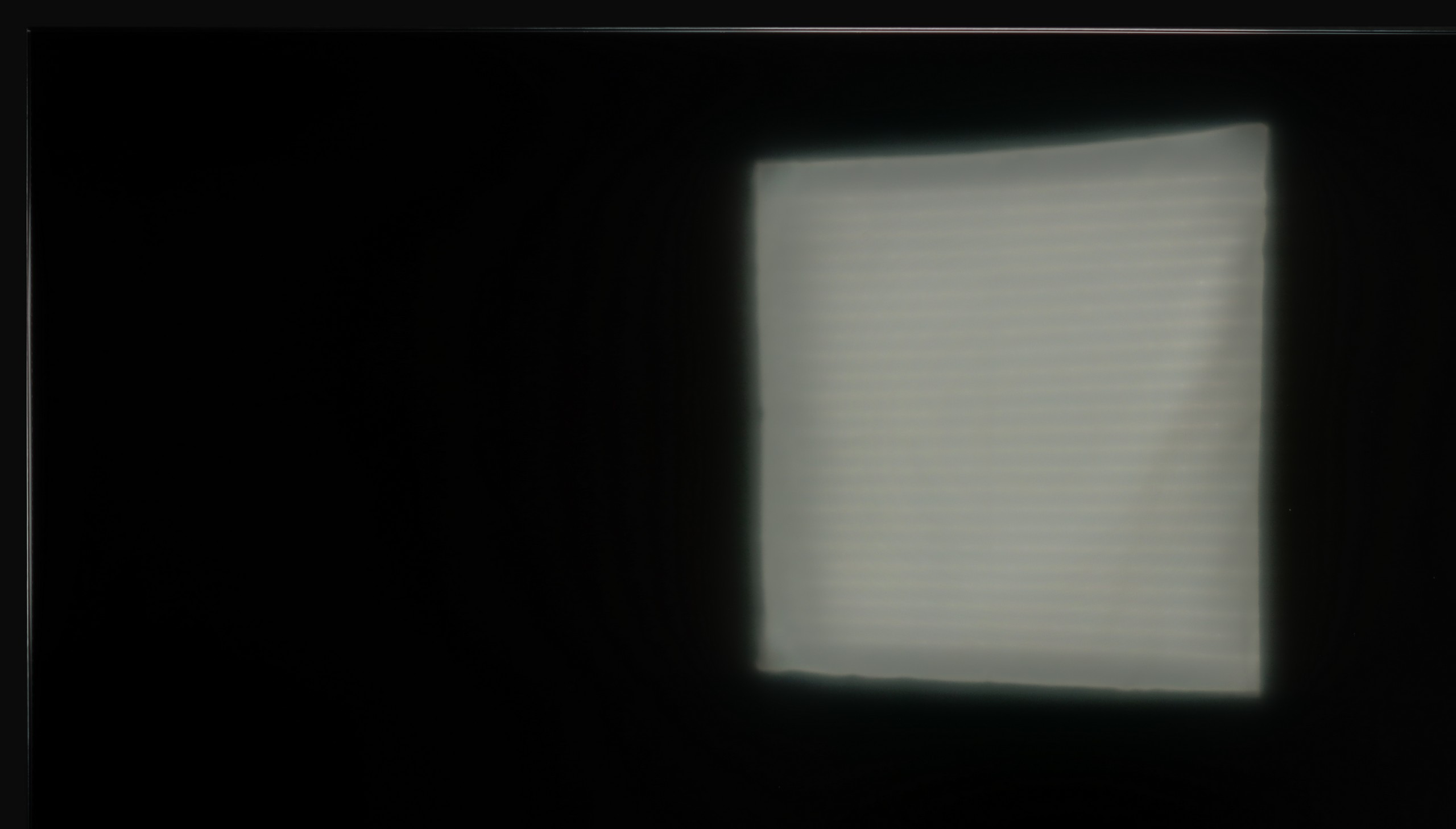


Matrix brightness
Average luminance SDR
TCL C7K / QM7K 55"-85": 529 cd/m2
Sony BRAVIA 5 (XR5) : 641 cd/m2
Bravia 5 is a device that performs really well in challenging lighting conditions. The high brightness ensures that even in the middle of the day, with the blinds wide open and sunlight streaming through the windows, the picture remains clear and sharp. There’s no sensation that we’re watching a “washed-out” screen. The satin coating of the panel also plays a significant role in effectively reducing light reflections. Yes, some reflections do appear, but they are not strong enough to interfere with viewing. They are more like subtle glows that can be noticed when we deliberately look for them, rather than a real problem on a daily basis. This means that the Bravia 5 will perform well not only in the evening in a dimly lit room but also in bright living rooms where other televisions can falter. Therefore, it can be said that it is a “universal light model” – suitable for both evening screenings and for watching news or sports in full sunlight.
Fortunately, the TCL C7K performs quite well in a bright room. The applied panel has a satin finish that effectively suppresses reflections, making it so that even on sunny days, we don’t have to worry about reflections from lamps or windows. Importantly, the colors maintain their intensity and do not wash out, as can happen with weaker matte panels. Regarding brightness itself, the average for content like YouTube or regular television reaches a little below 500 nits. It’s not a record-setting result— for example, the MQLED85 (C765) performs better in this regard. However, for everyday watching during the day, it should work without major issues, as long as we don’t plan to place it opposite a south-facing window without curtains.
Details about the matrix
Subpixel Structure:
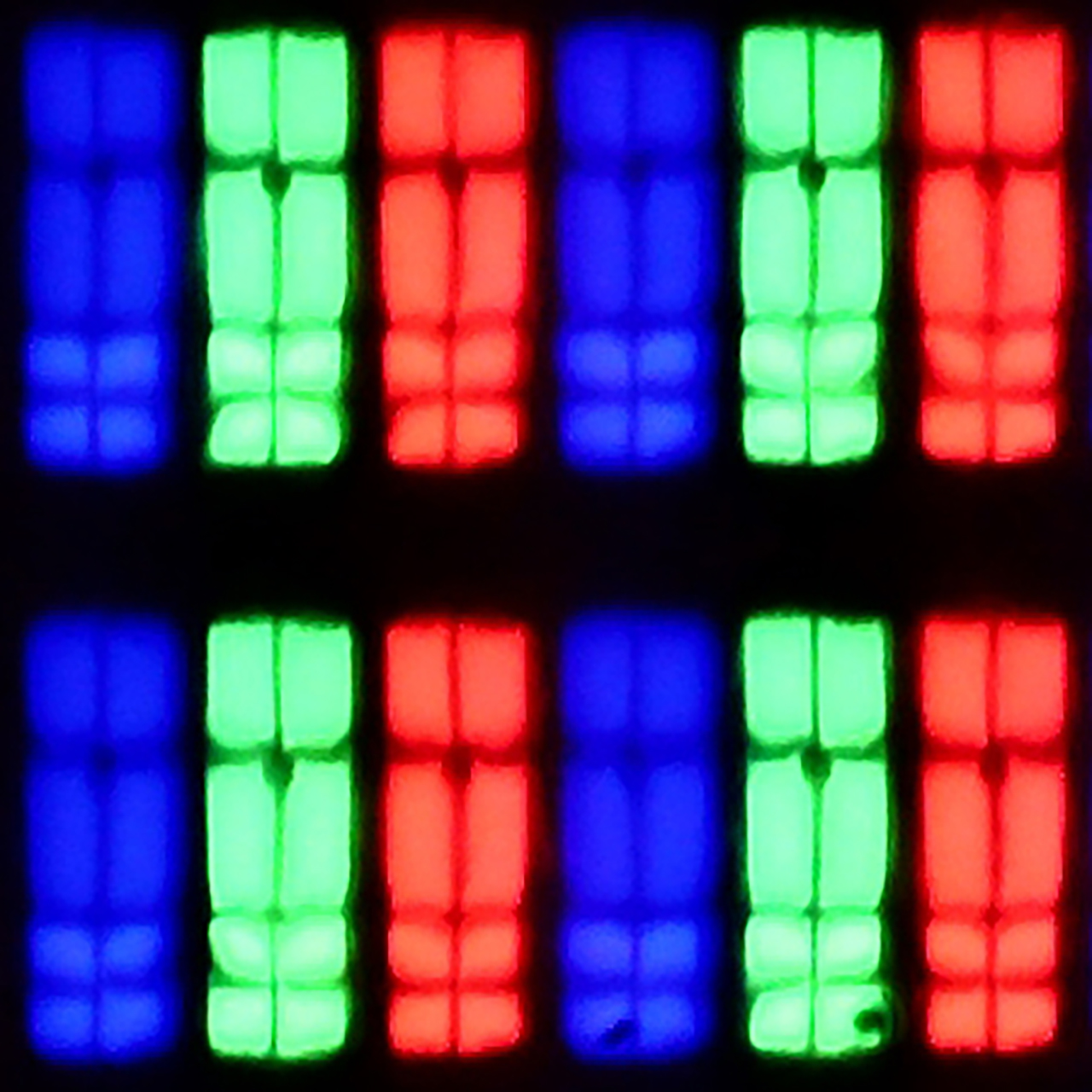
Panel uniformity and thermal imaging:

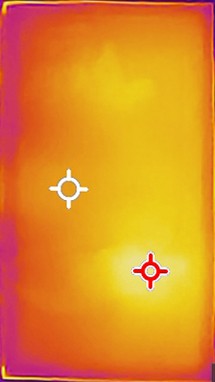
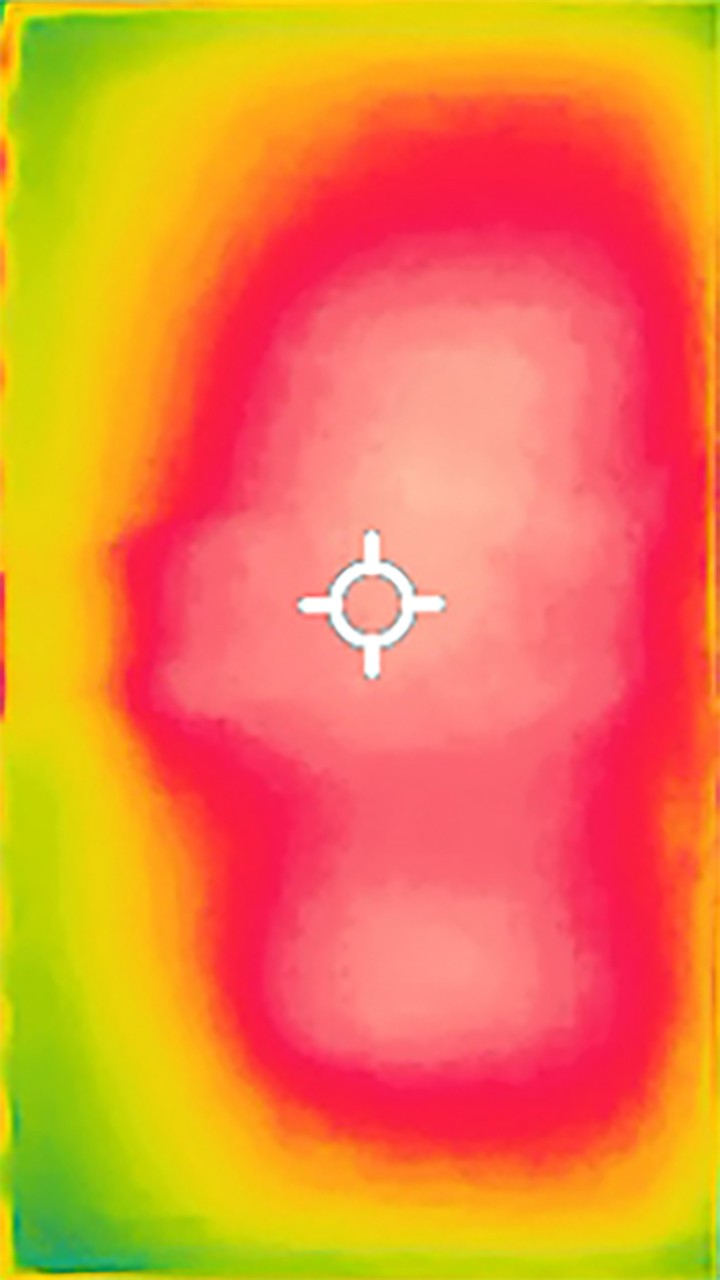
Sony BRAVIA 5 (XR5)
TCL C7K / QM7K 55"-85"
TV features
7.6/10
7.3/10
- HDMI inputs2 x HDMI 2.0, 2 x HDMI 2.1 48Gbps2 x HDMI 2.0, 2 x HDMI 2.1 48Gbps
- OutputsToslink (Optical audio), eARC (HDMI), ARC (HDMI)Toslink (Optical audio), eARC (HDMI), ARC (HDMI)
- Network InterfacesWi-Fi 2.4GHz, Wi-Fi 5GHz, Ethernet (LAN) 100MbpsWi-Fi 2.4GHz, Wi-Fi 5GHz, Ethernet (LAN) 100Mbps
- TV receptionDVB-T, DVB-T2, DVB-S, DVB-S2, DVB-CDVB-T, DVB-T2, DVB-S, DVB-S2, DVB-C
Classic features:
- Recording to USB (terrestrial TV)
- Recording programming
- Picture in Picture (PiP)
- RF remote control (no need to aim at the screen)
- Backlit remote control
- Teletext
- Audio only mode
- Bluetooth headphones support
- Simultaneous Bluetooth headphones & TV audio
Smart features:
- AirPlay
- Screen mirroring (Windows Miracast)
- Voice search
- Voice search in native language
- Ability to connect a keyboard and mouse




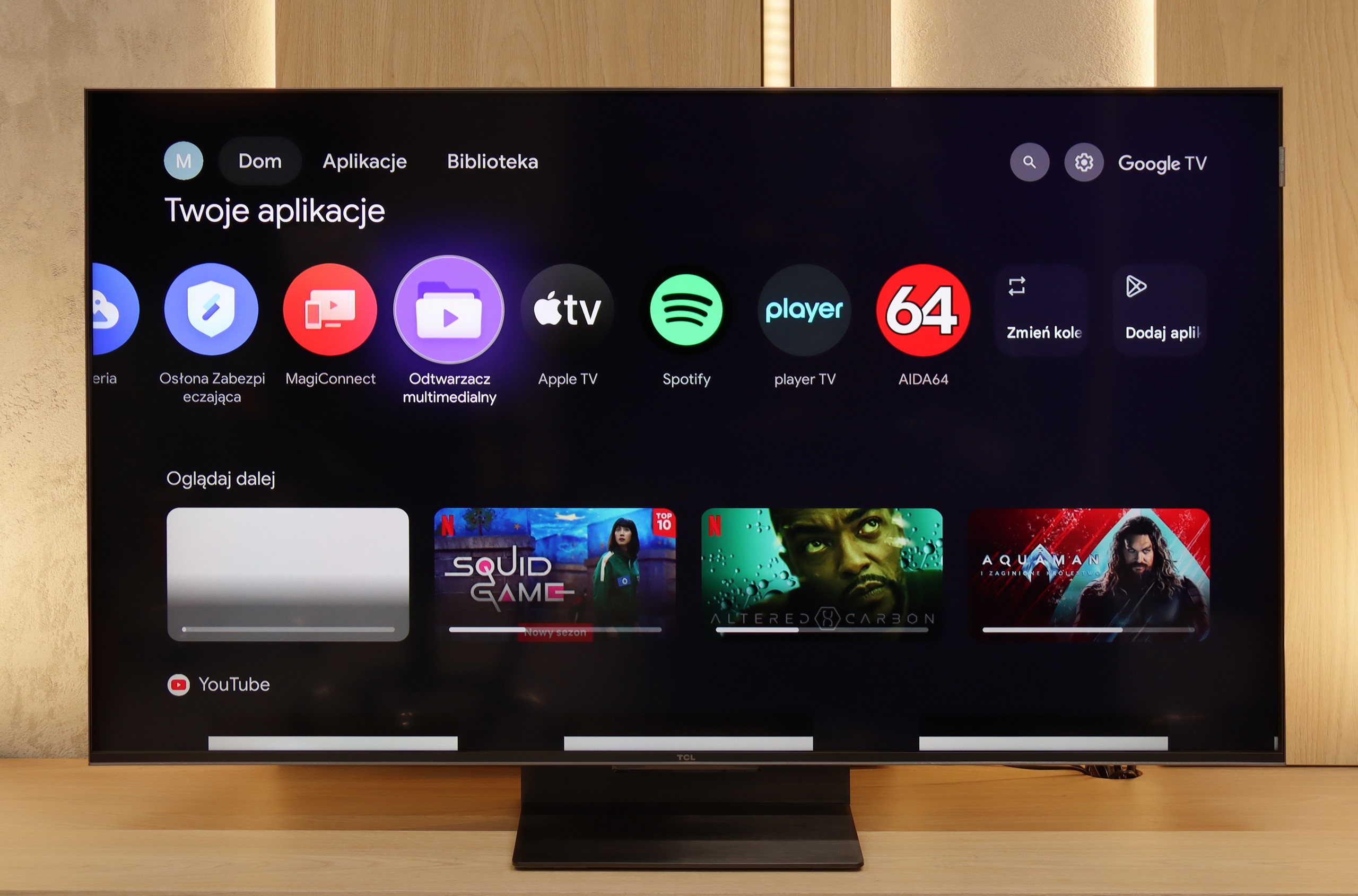
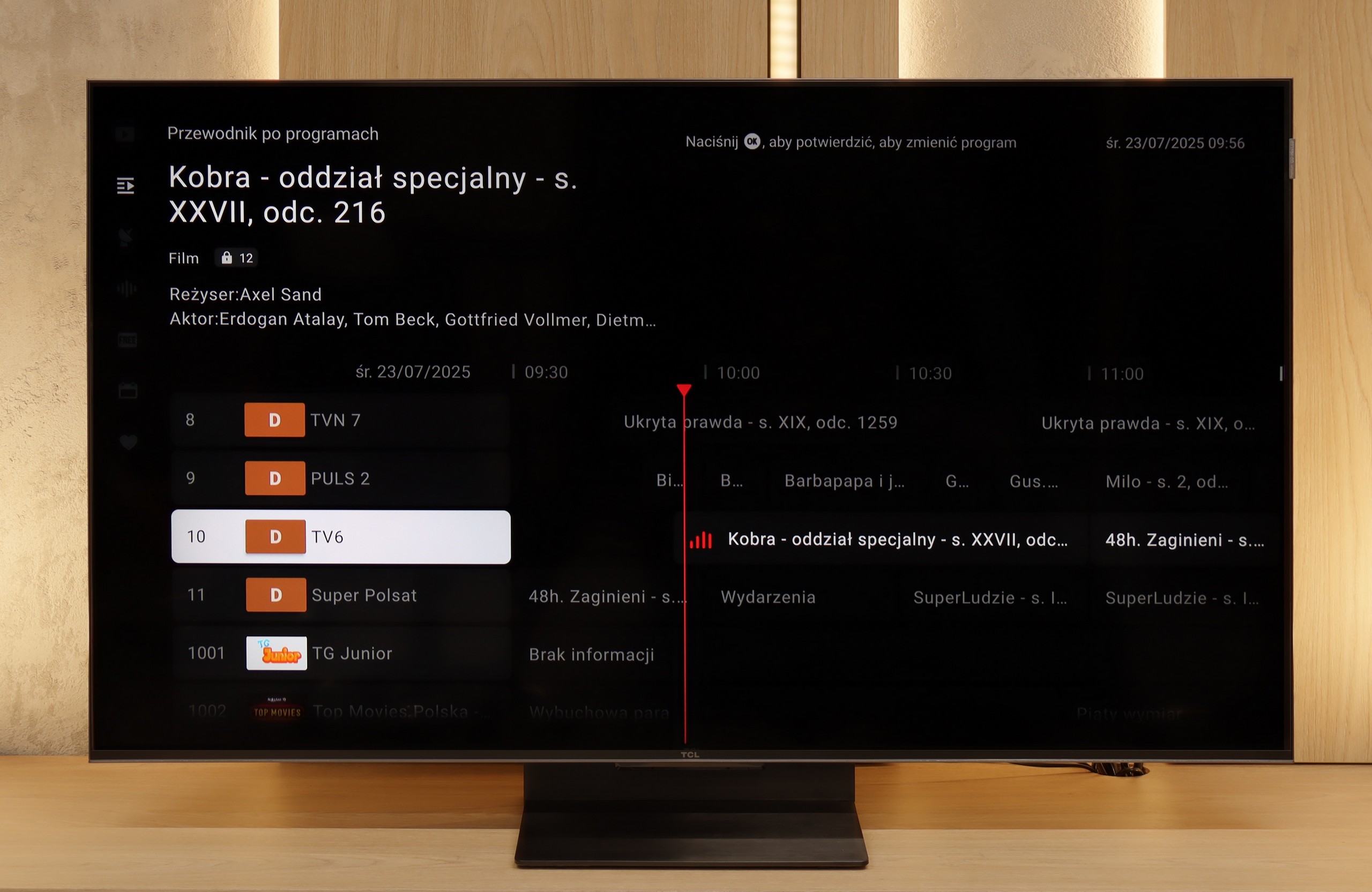
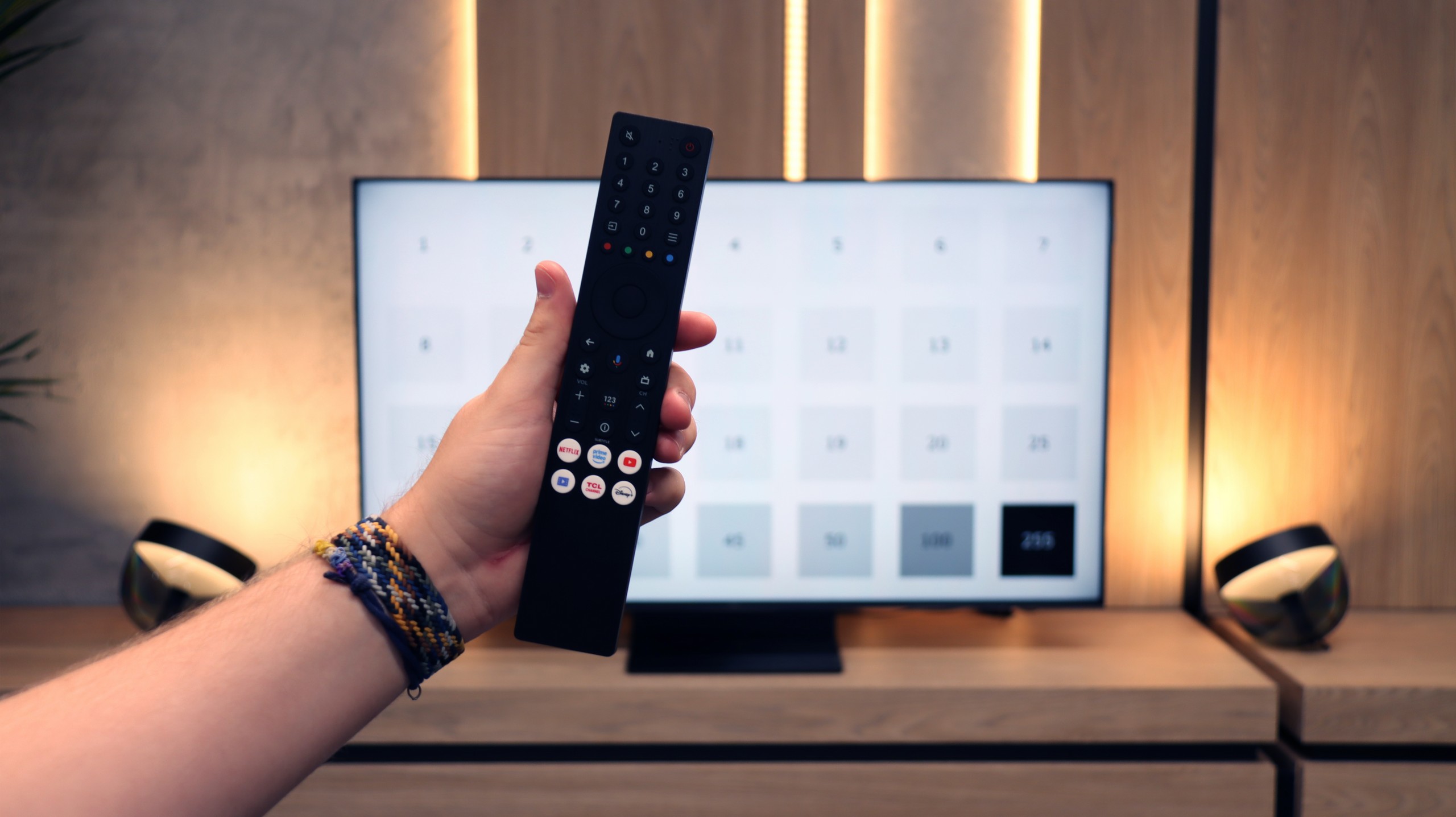
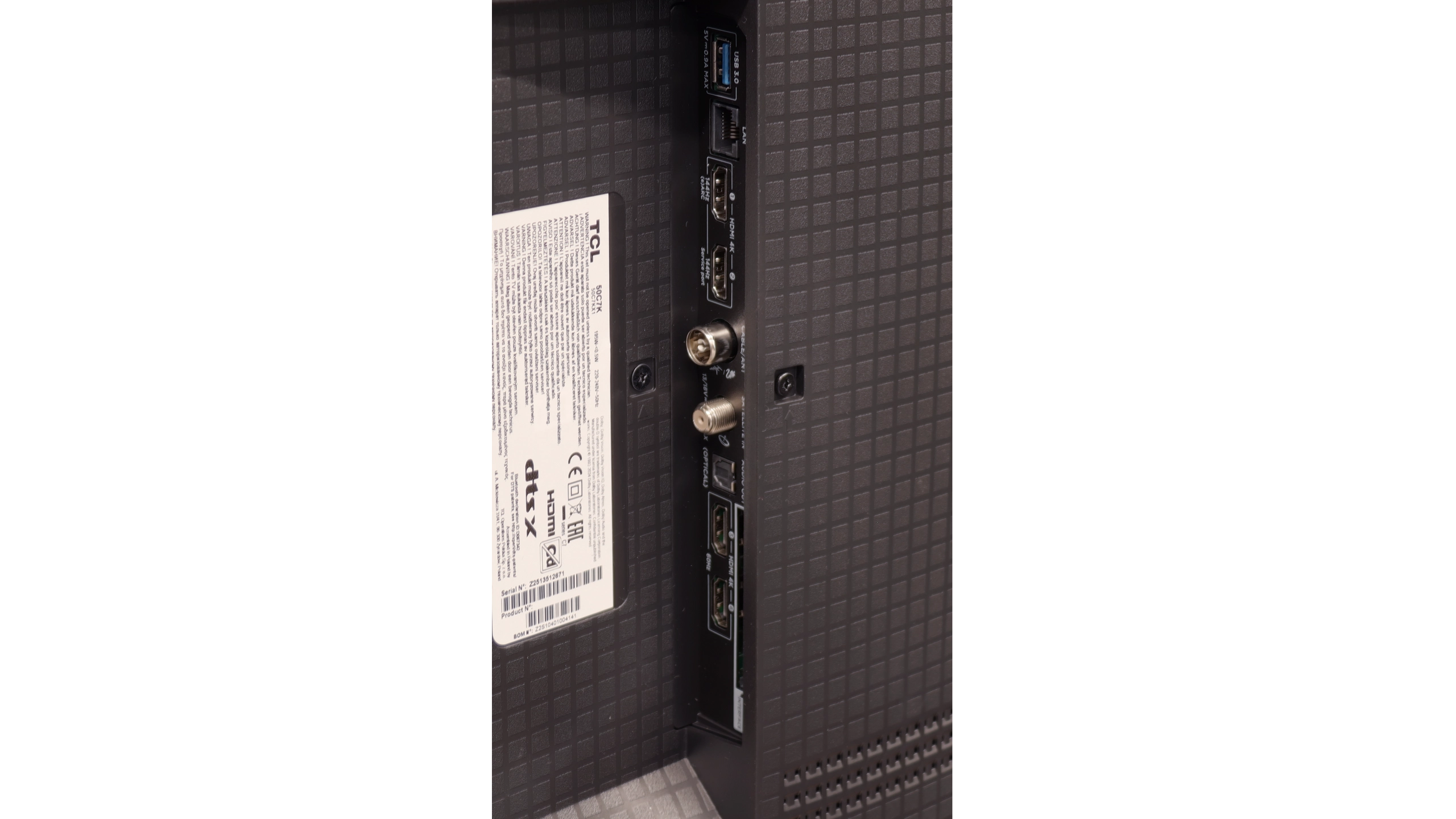
GoogleTV and SmartTV features
Sony Bravia 5 runs on Google TV, and it must be admitted that it is one of the best-optimized systems specifically for this brand. The interface runs smoothly, there are no annoying bugs or strange translations, and navigating the menu does not feel like walking through a minefield. Indeed, there are moments when the system stutters a bit—as if it has its “weaker moments”—but these are so rare that they do not spoil the overall impression. We have full support for AirPlay, voice search with the help of Google AI assistant, and the possibility of downloading virtually any app we can think of. The only downside in testing turned out to be the screen mirroring feature, which theoretically should work with laptops and phones, but in practice proved to be almost useless—on Windows and Android, it was impossible to obtain a stable image.
User features
On the side of classic features, Bravia 5 stands solidly and practically. A big plus is the presence of two remotes—one is a slim, modern smart remote, while the other, although working via infrared, has a traditional numeric keypad. This way, we can always choose which one fits the situation better. The EPG, or electronic program guide, is clear and allows you to program recordings to a USB drive—a seemingly simple solution, but extremely useful. Additionally, the television supports the connection of various devices: from an amplifier or soundbar via HDMI eARC, to headphones and other wireless accessories via Bluetooth. This is a setup that makes the television not just a screen, but a well-thought-out home entertainment center.
SmartTV: GoogleTV
The biggest strength of the TCL C7K in everyday use is undoubtedly the Google TV system. Thanks to it, we have access to an almost endless library of applications, including those more niche ones that are often unavailable on other platforms. The built-in Google Assistant understands Polish, so we can easily ask what is on TV, what the weather is like, and even issue a few voice commands to control the television. We also have to appreciate the presence of Chromecast and AirPlay, which work smoothly and make life easier.
Usability Features
On the downside, the classic features perform a bit worse. Of course, we will find the basics here – teletext, EPG, or the ability to connect headphones – but that's basically it. There is a lack of USB recording functionality and picture-in-picture (PiP) mode, which can still be found with the competition at times. It is also worth noting that Google TV in the TCL version can sometimes have oddly translated fragments of the menu or minor interface bugs. These are not things that hinder everyday use, but detail-oriented people might notice them.
Playing files from USB
8.9/10
9.2/10
Supported photo formats:
Maximum photo resolution:

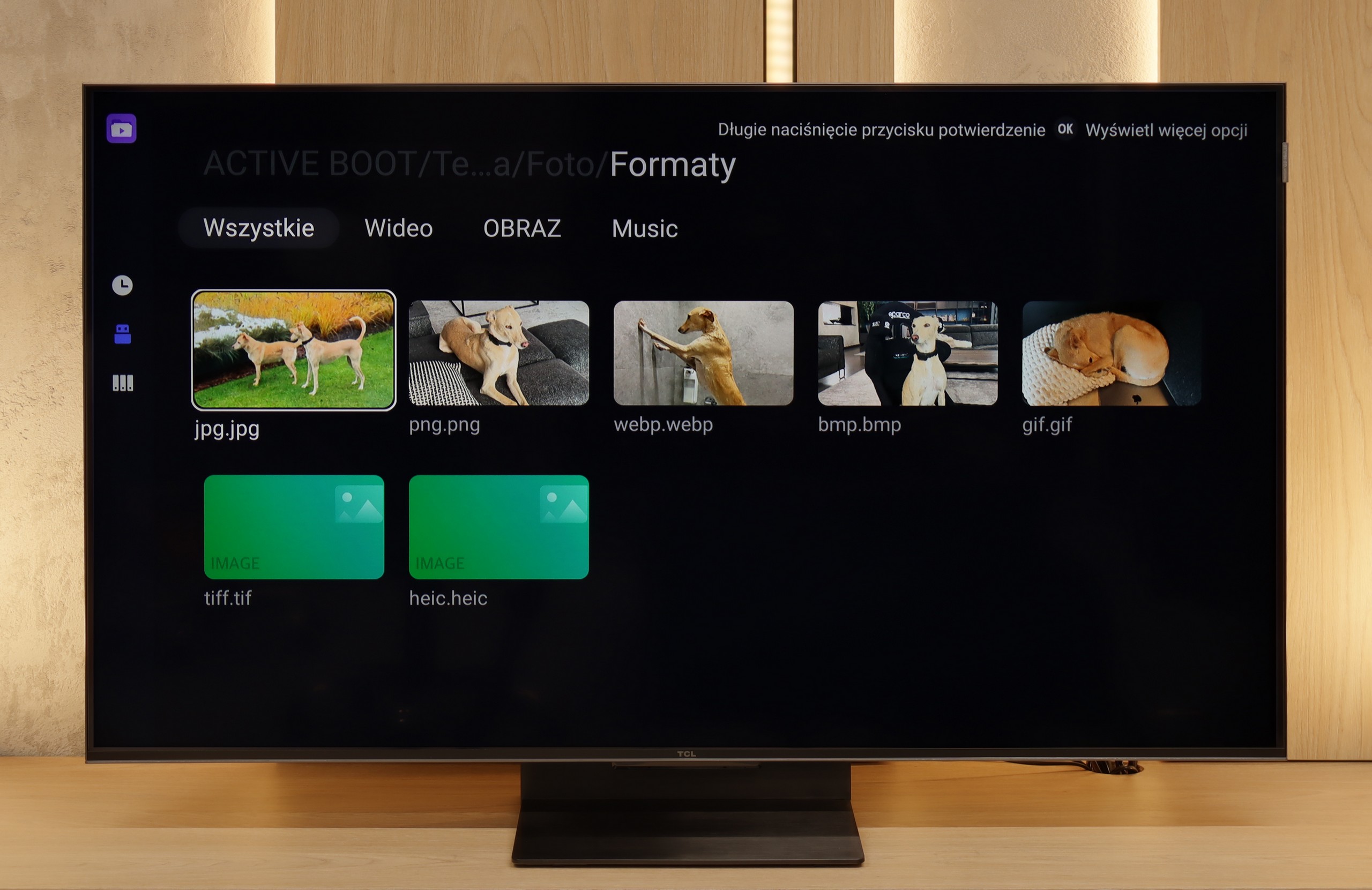
Bravia 5 handles multimedia playback from USB quite efficiently. In practice, almost everything works – movies, music, photos – although we did encounter some minor issues. Some subtitles can cause problems, as can exotic photo formats, which were not always recognized correctly. However, this is standard in the world of TVs, and it's hard to take offense at it seriously. A significant advantage is the fact that thanks to Android, we are not limited to the system's player. Simply installing an external app, like VLC, eliminates all restrictions. This is the advantage of this system – the manufacturer does not confine us to their ecosystem, but rather gives us the freedom of choice.
The built-in file player in the TCL C7K performs really well. It supports most popular audio and video formats, so if we want to quickly load something from a USB drive and play it, there shouldn't be a problem. Of course, as is often the case, there can be some minor shortcomings – not every exotic codec will work (Apple's HEIC), not all subtitles will be perfectly synchronized (txt.). However, the biggest advantage of this television comes to the rescue, which is Google TV. Thanks to access to the Google Play Store, we can easily install an alternative player, such as VLC, and then no file will be a challenge for us.
Apps
9.6/10
9.6/10














































Sound
7/10
7.7/10
- Maximum volume84dB-
- Dolby Digital Plus 7.1
- Dolby True HD 7.1
- Dolby Atmos in Dolby Digital Plus (JOC)
- Dolby Atmos in Dolby True HD
- DTS:X in DTS-HD MA
- DTS-HD Master Audio
Bravia 5 positively surprises in terms of audio. The sound is pleasant, with a slightly noticeable bass thanks to the proprietary Bass Reflex speakers. The overall output is loud, clear, and decidedly above average for a television – 40 W of power in a 2.2 configuration is an impressive result in this class. The placement of the speakers on the sides of the housing also plays a significant role here, allowing the sound to spread across the room and providing a sense of space. However, one shouldn't get carried away with optimism. It is still not at the level of even the simplest soundbar. The Bravia 5 performs excellently in everyday use, but for those who enjoy powerful sound and a cinematic effect, additional audio equipment will be a must – just like with nine out of ten televisions available on the market today.
In larger versions of the C7K (from 55 inches and up), the sound makes an even better impression than in the smallest, 50-inch variant. This is due to the greater number of built-in speakers and additional channels that provide a fuller, more spacious sound. The bass becomes clearer, dialogues gain clarity, and sound effects can truly fill the room.
It's worth mentioning the collaboration between TCL and the Bang & Olufsen brand, which appeared in the 2025 models. Even if we are not a hundred percent sure whether original drivers from the Danish company are working inside, the final effect is surprisingly positive. As far as a TV without an additional soundbar goes, the larger C7K models offer sound that can be enjoyed even during longer movie sessions.
Acoustic Measurements
84dBC (Max)
75dBC
No acoustic data


